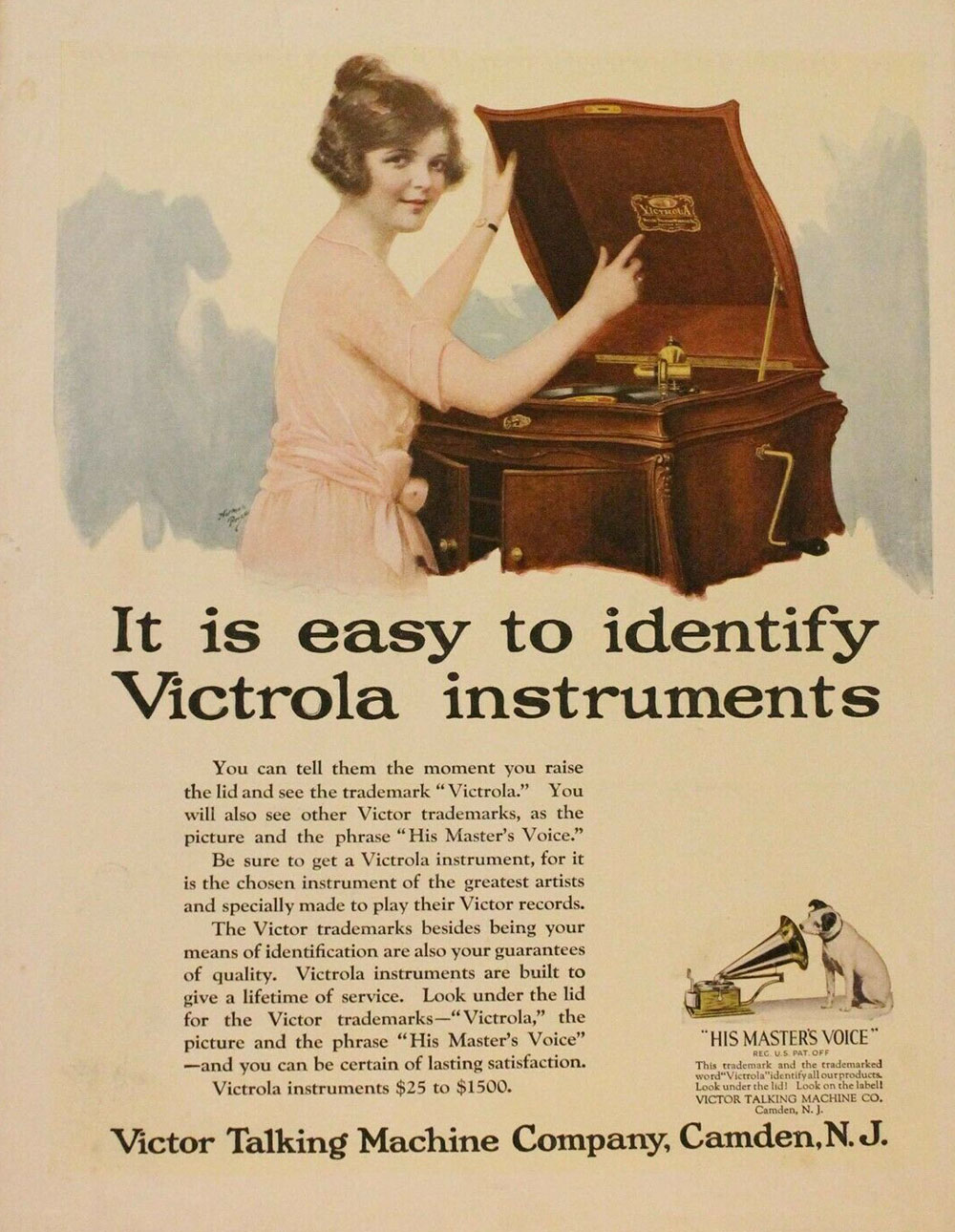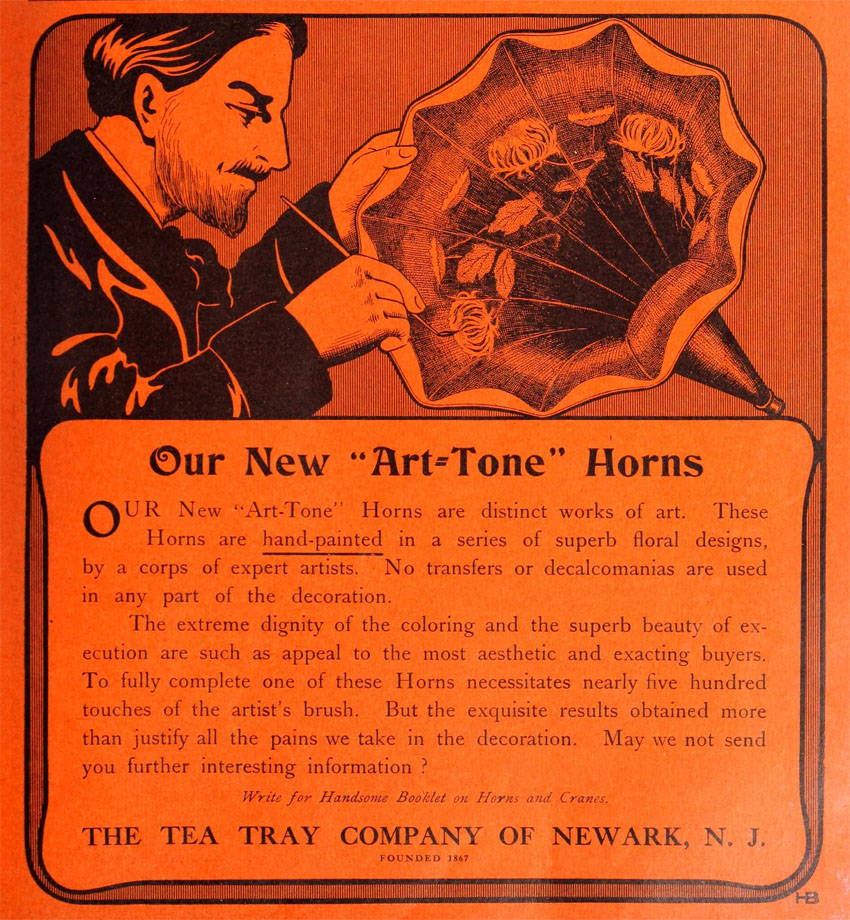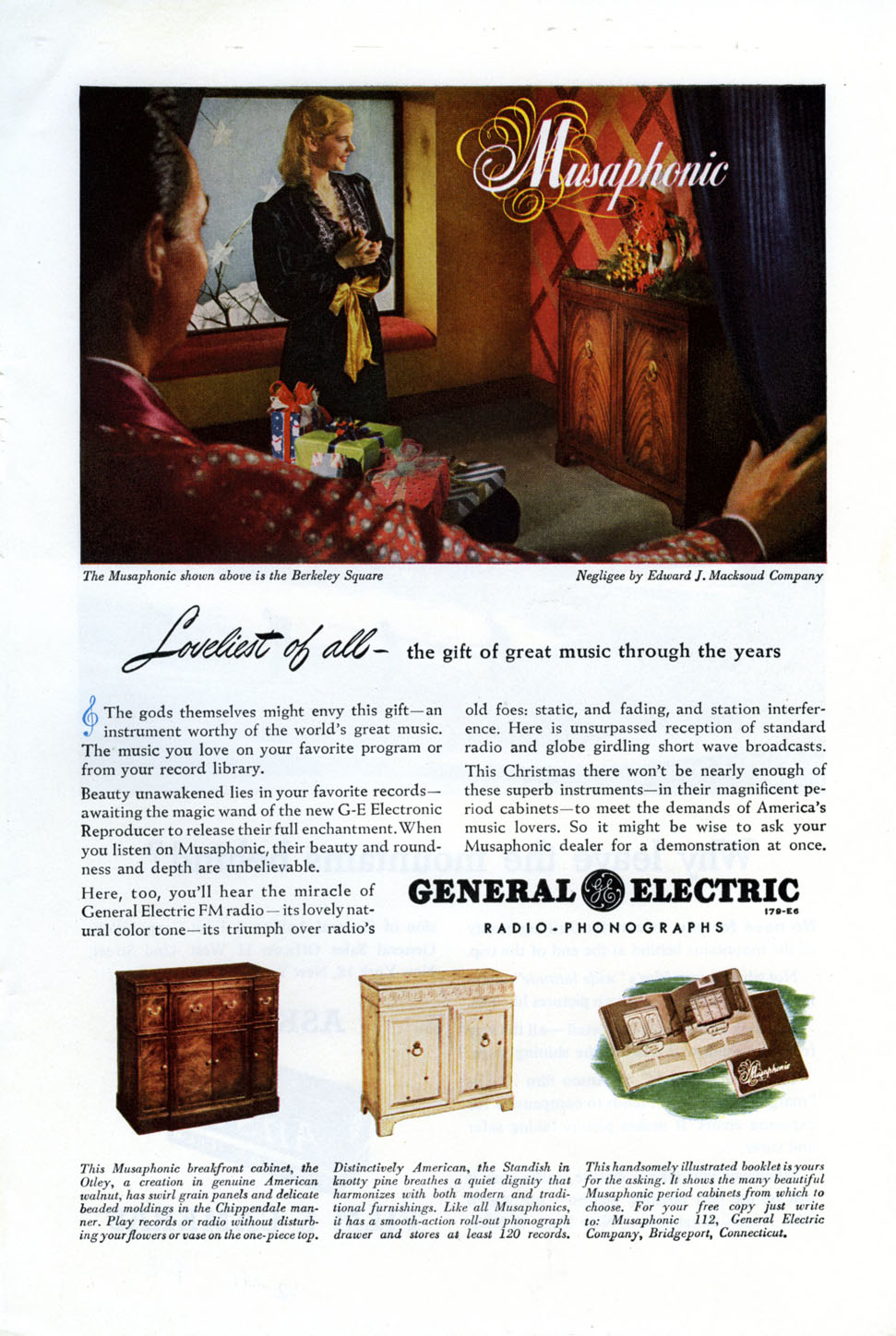PhonoElegance
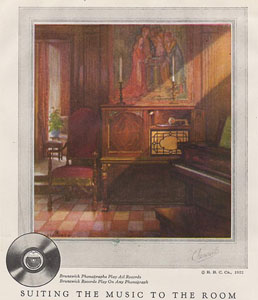
Removing
the Horn from the Room
By Doug Boilesen, 2007
In August of 1906 a significant
change took place that would refine and redefine talking machines.in
the home. A new product-line called the Victor-Victrola was
introduced and aesthetically it helped the talking machine to
more easily find its place in the home. The talking machine's
external horn was gone -- moved inside the cabinet -- and in
so doing the Victrola in popular culture became fine furniture,
a musical instrument and a trademark that would become a generic
term for all talking machines, like Kodak for cameras and Kleenex
for tissues.
Victor Talking
Machine Company, 1910
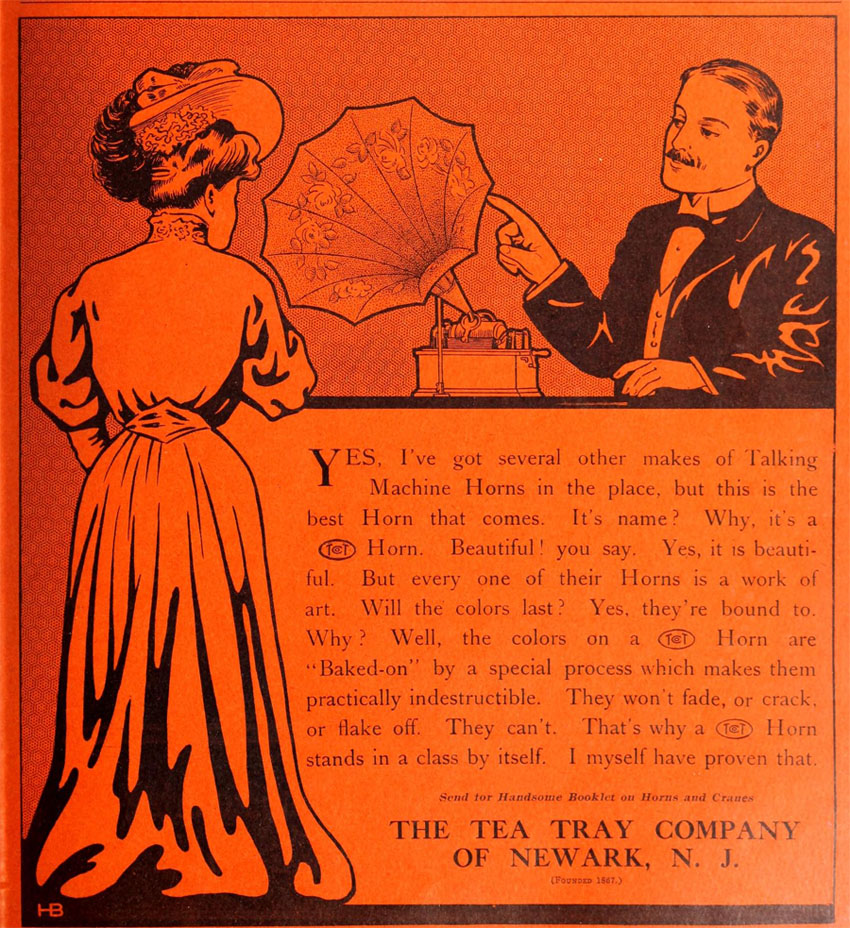
The horn. "It's
beautiful" says the elegantly dressed customer. "Yes,
it's beautiful" says the salesman. The
Talking Machine World cover ad, April 15, 1907
"Horns are distinct works
of art. These Horns are hand-painted in a series of superb floral
designs..." The
Talking Machine World cover ad, May 15, 1907
This lovely 1908 poster advertising
the Edison Phonograph shows Edison's attempt at elegance for
his cylinder phonograph with the artist Guernsey Moore appealing
to the popular culture interest in Japanese culture that had
developed in the 1880's for Japanese prints, and parasols and
paper lanterns. This image is particularly interesting because
it included a flowered horn, something for which Edison's own
dealers would complain about since Edison didn't offer flowered
horns as standard equipment so that this horn is not something
you would see in the Edison catalogue.
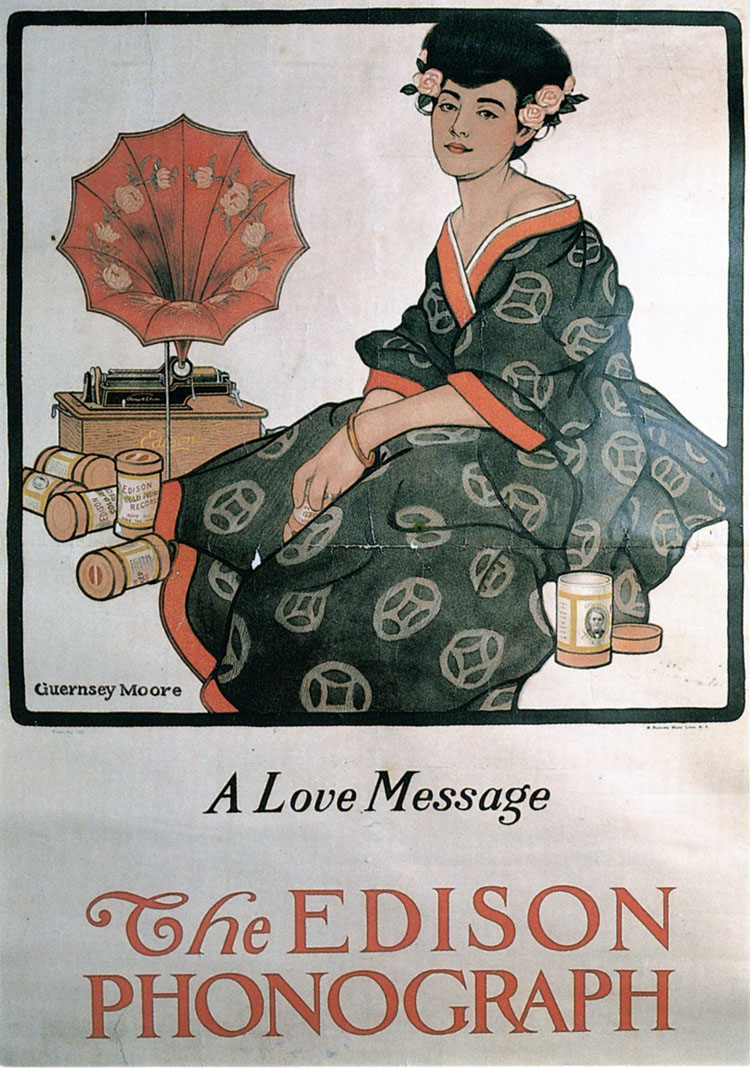
With the introduction of the Victor-Victrola,
however, flowered horns would be the least of Edison's challenges.
Internal horn machines that played disc records would soon dominate
the market and period piece phonographs would become highly
advertised options in the late teens and 1920's. Advertisements
showing wealthy homes would be displayed as "suiting the
music to the room."
Victor Talking Machine
Company, 1913

"Throw out your
horn machine..." The Phonola, circa 1919
Moving the horn inside a cabinet
would be a revolutionary design change, however, there were
other creative designs such as making a phonograph into a desk.
The Columbia Grafonola "Regent" model, for example,
advertised that it was not a "mere concealed-horn
graphophone, but "a completely concealed graphophone"
providing practically unlimited entertainment and utility "wherever
people of refinement congregate."
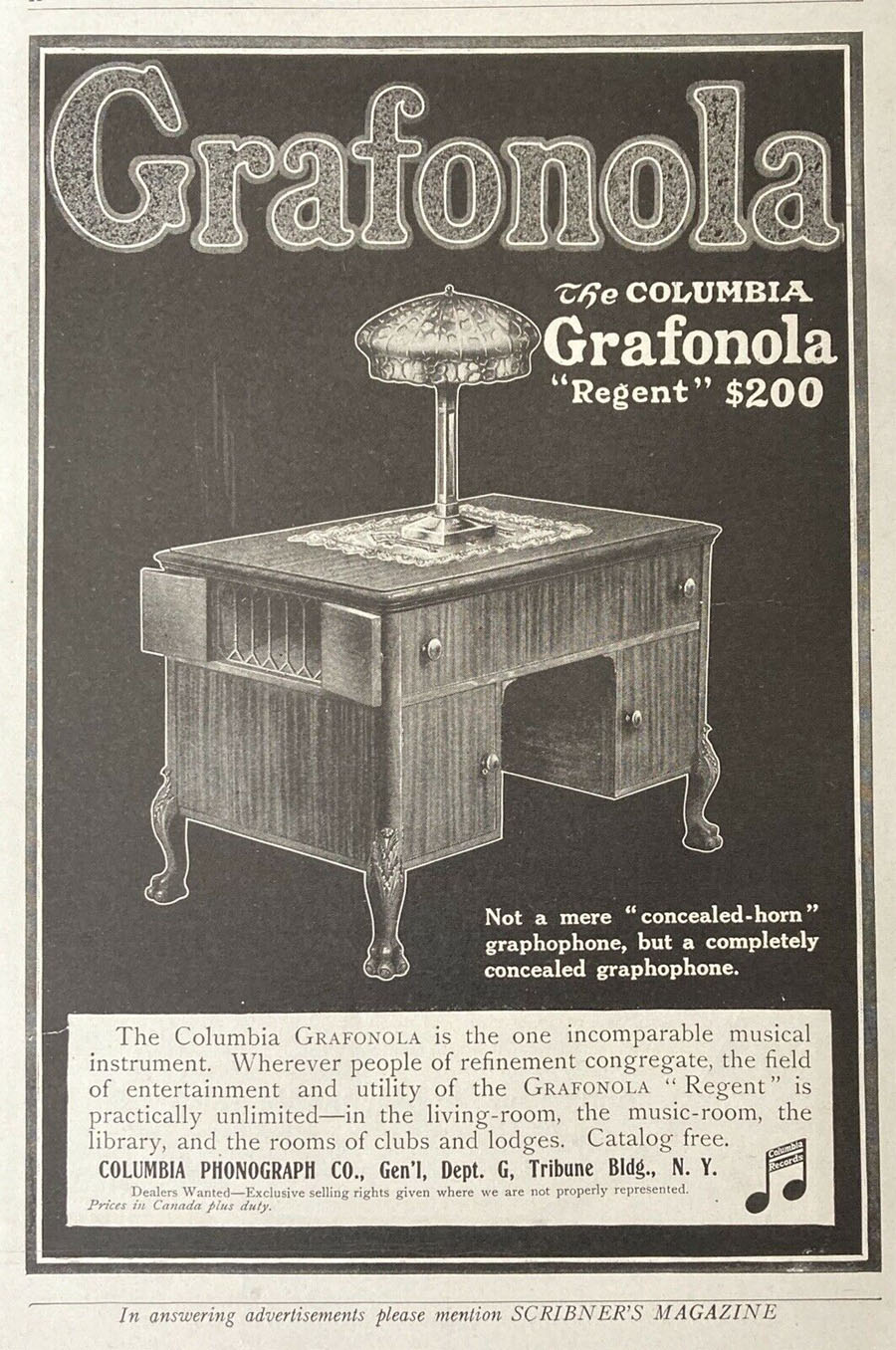
The Columbia Grafonola
"Regent," Scribner's Magazine, 1910
Period design phonographs
with cabinetry "enthusiastically
welcomed by connoisseurs of fine furniture" was a niche
market with low expectations by the phonograph industry for high
sales. Rather these were to be symbols of the quality that customers
were to associate with the other phonographs made by that same
company that cost considerably less. All phonographs could bring
the "stage
of the world" into the home. But the platform for that
stage, or as one Columbia ad called it "an appropriate
setting" for that music, could vary. As the following ad
explains these period design phonographs provided elegant
stages for listening to records that also met another "genuine
need."
"More than
ever American women are giving careful attention to the harmonious
furnishing of their homes. In response to a genuine need, the
Columbia Grafonola has led the way in worthily adapting to the
uses of good music the best designs of the world's master craftsmen."
The Ladies' Home Journal, October 1918
The elegance in phonograph cabinetry
is an example of the phonograph's exclusivity marketing. Consumers
could see these artistic phonographs in magazine ads and store
windows but only a few would actually be purchased. Creating
desires is an attribute of capitalism and much greater excesses
in marketing than phonograph period piece furniture have certainly
taken place. But as Naomi Klein asks in her book "On Fire"
regarding the general unsustainable "consumption tidal
wave" in modern society, are we now "ready to have
a more probing conversation about the limits of lifestyles that
treat shopping as the main way to form identity, community,
and culture." (1)
For indeed, promotions effectively
said that by purchasing period design phonographs consumers
could acquire the identity of exclusivity, the community of
privilege, and culture associated with the original period designs
that "are among the chief treasures of American and European
art museums."
Brunswick's supercraftmanship
in their cabinetry was advertised as vying with the artistry
of the middle ages "leading
to unexpected adventures in suiting music to the room."
A period design phonograph, said
another ad, was a 'musical instrument that was worthy of its
music, a machine that could deliver the 'best music of all ages.'
For "connoisseurs" and
those who wanted "Fine
Music and Fine Furniture United" the period phonographs
were advertised as having "ardent appeal."
In reality, however, owning a
period cabinet phonograph did not improve the music nor the
quality of recorded sound. Nor would there be the added charm
of Louis XVI listening
to the music with you.
Legacies of period design phonographs
are the machines as artifacts, its associated ephemera and
its contributions to consumerism of its time.
The marketing and shopping for
those period design phonographs can be reviewed by time-traveling
to circa 1920 and looking at their respective ads, visualizing
the shoppers, and examining the period design phonographs that
were built as artistic cabinets to fullfill what the industry
said was "a genuine need" and "worthy of a place
in your home."
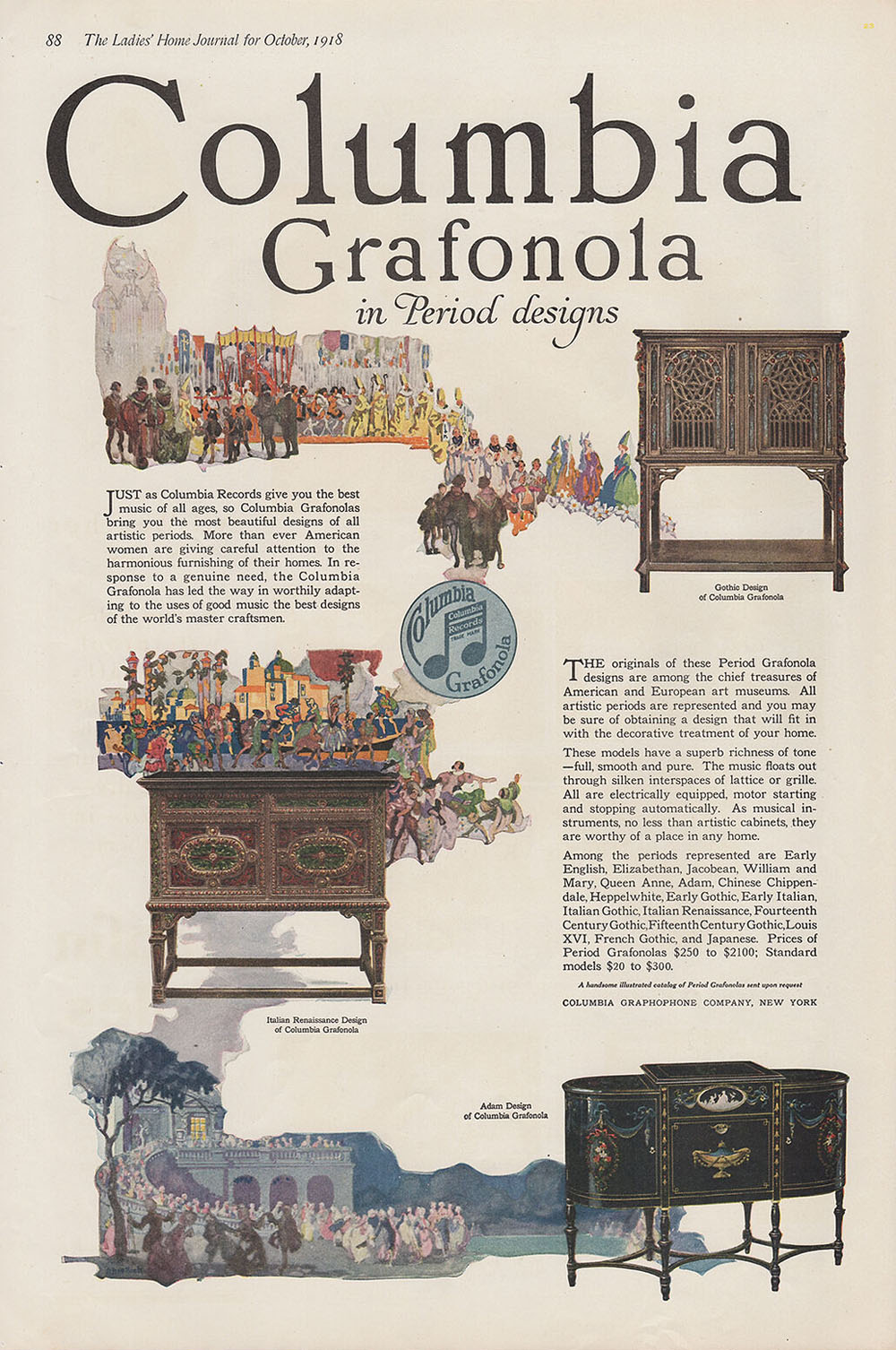
"In response
to a genuine need...Worthy of a place in any home." Period
Grafonola - Italian Renaissance and Adam Designs, The Ladies'
Home Journal, October 1918
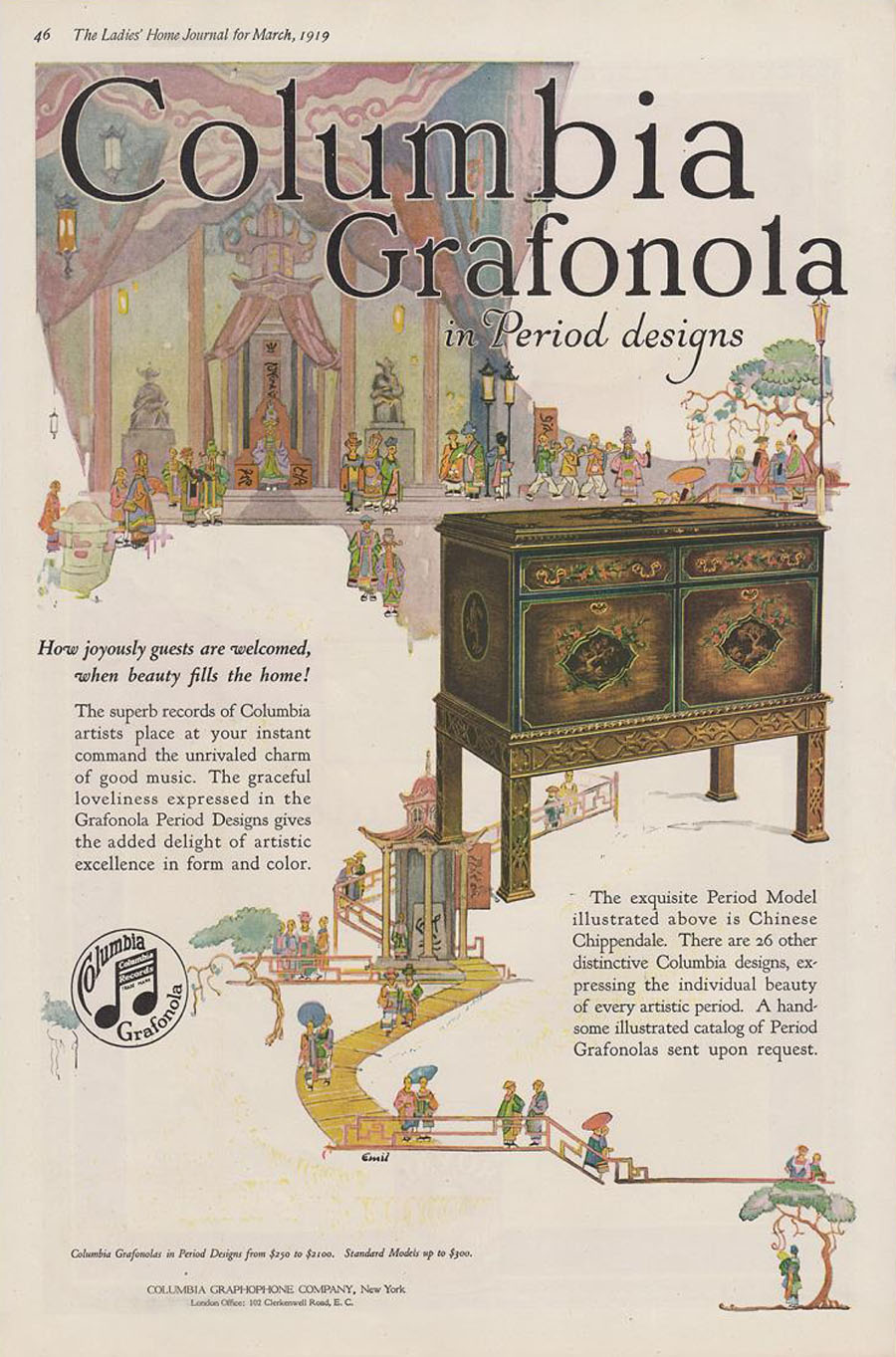
Period Grafonola
- Chinese Chippendale, The Ladies' Home Journal, March
1919
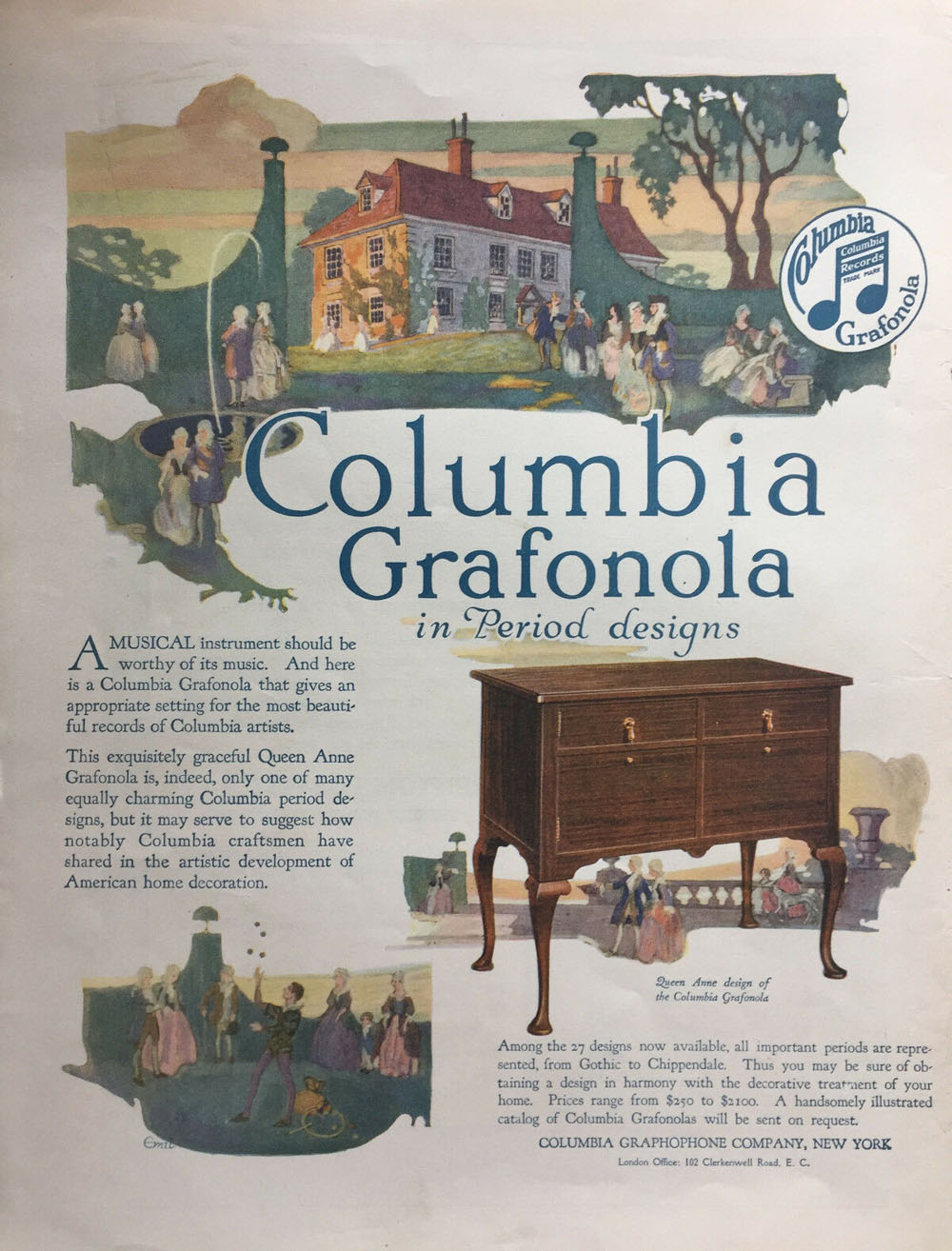
"A Musical instrument
should be worthy of its music" and provide "an appropriate
setting for the most beautiful records..." Period
Grafonola - Queen Anne, The Literary Digest, February 8,
1919
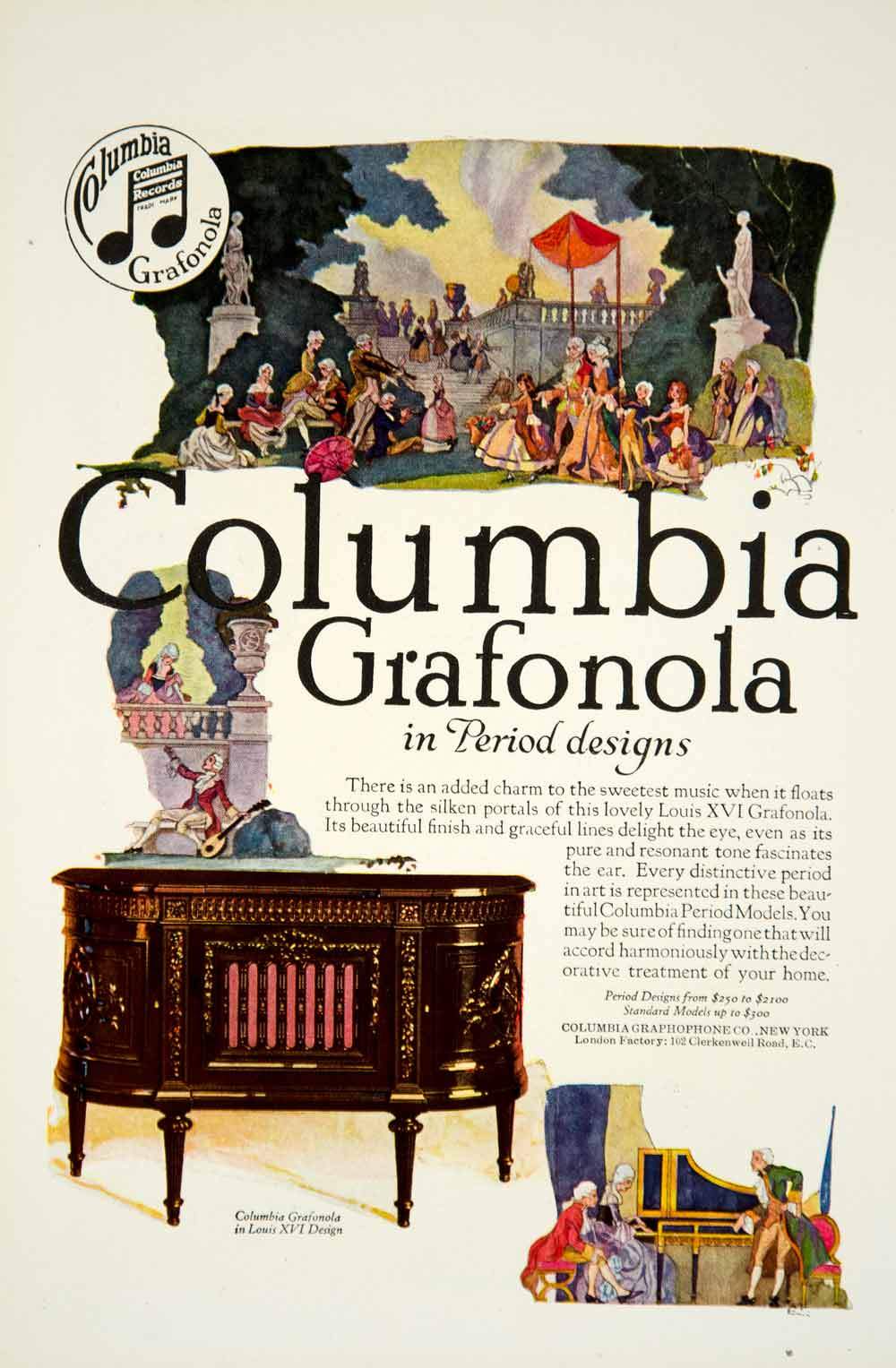
Period Grafonola
- Louis XVI Design 1919
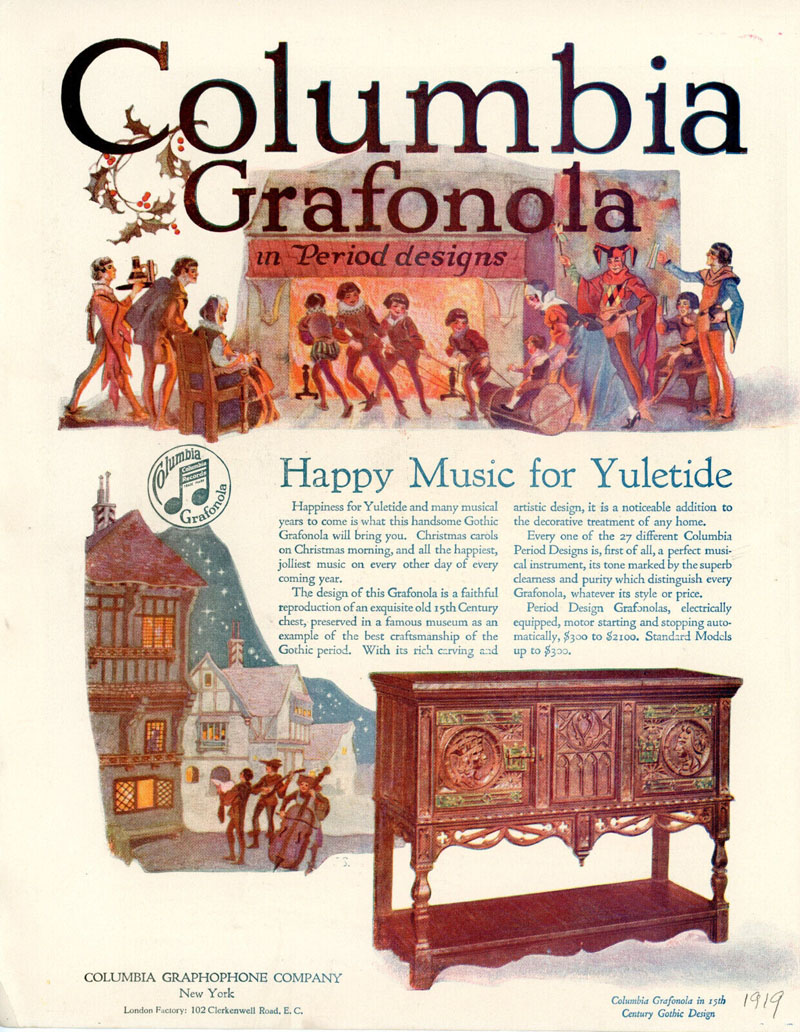
Period Grafonola
in 15th Century Gothic Design, 1919 (PM-2126)
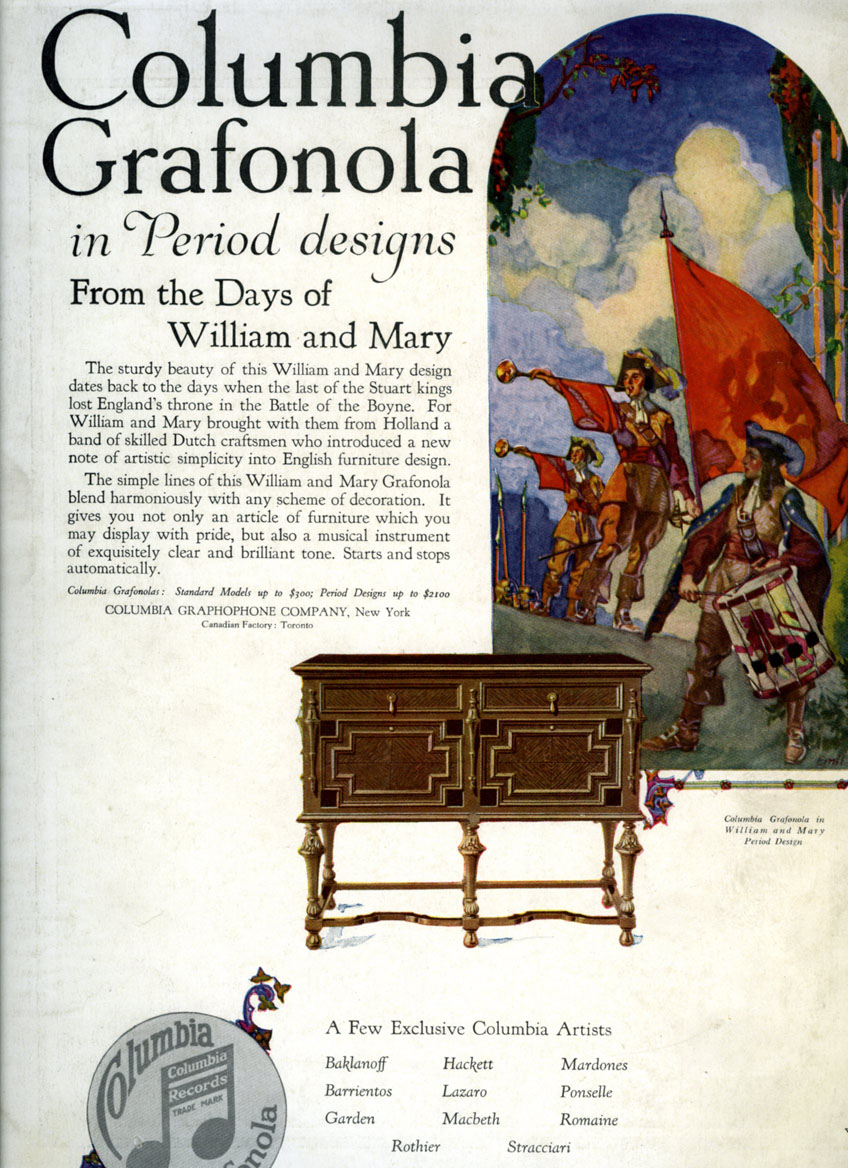
Period Grafonola
- William and Mary Design, Country Life, 1920 (PM-2011)
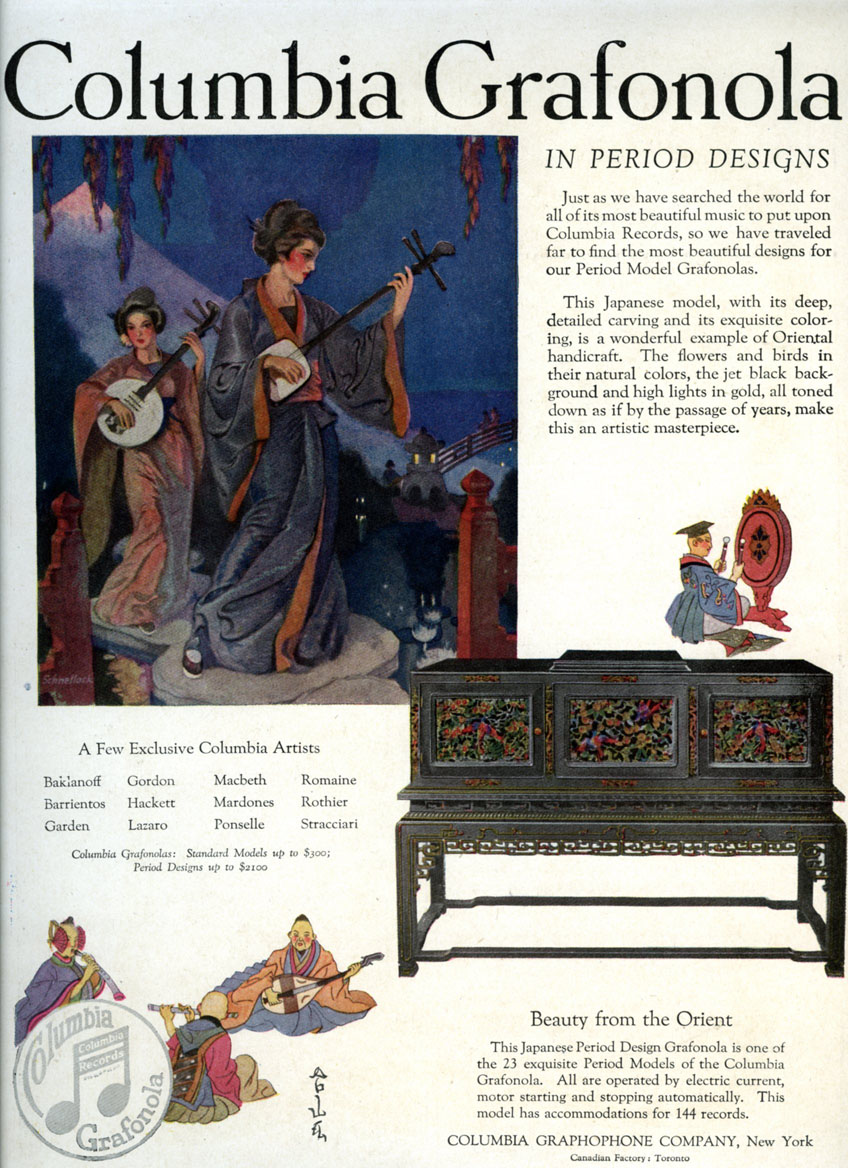
Period Grafonola
- Japanese Period Design, "Beauty from the Orient,"
Country Life, 1920 (PM-2012)
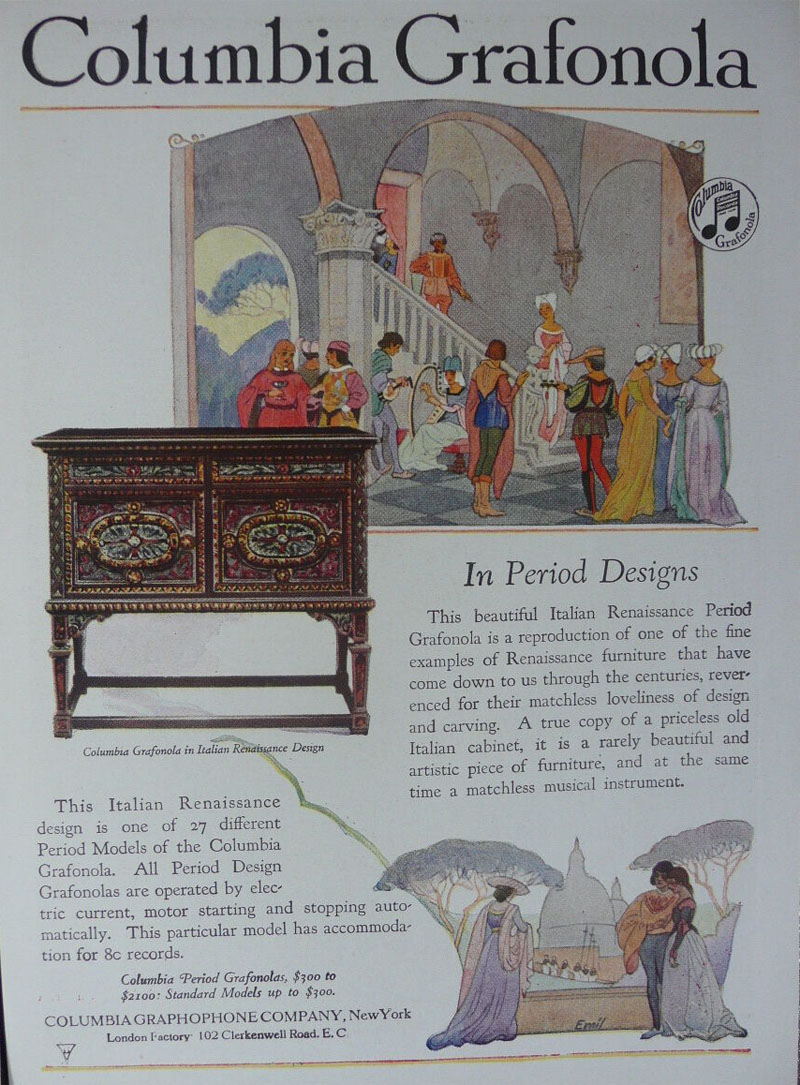
Period Grafonola
- Italian Renaissance Period Design, 1920
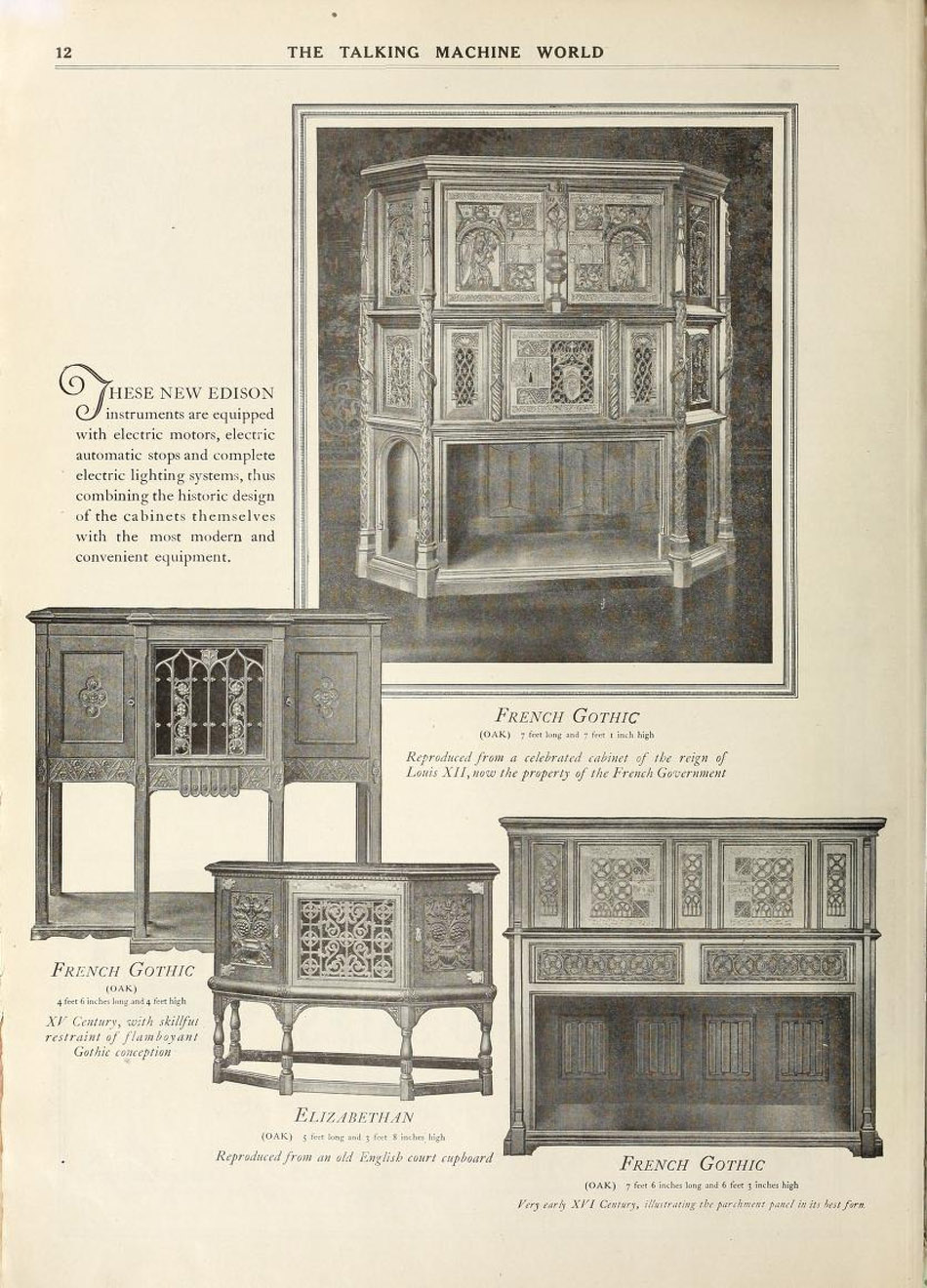
The Talking Machine
World, January 15, 1917
In the two-page Edison
ad the price the consumer is paying for the historic cabinets
versus its functionality is made clear in an "announcement"
that Mr. Edison was said to have required to be made in this ad:
"Those
who are concerned soley in obtaining the best musical result
need not pay more than $250, as the Official Laboratory Model,
which sells at $250, is equal in musical sense to the most expensive
models. It is in fact the model we have used in the public comparisons
at Carnegie Hall and elsewhere between the living voice and
our Re-Creation of it."
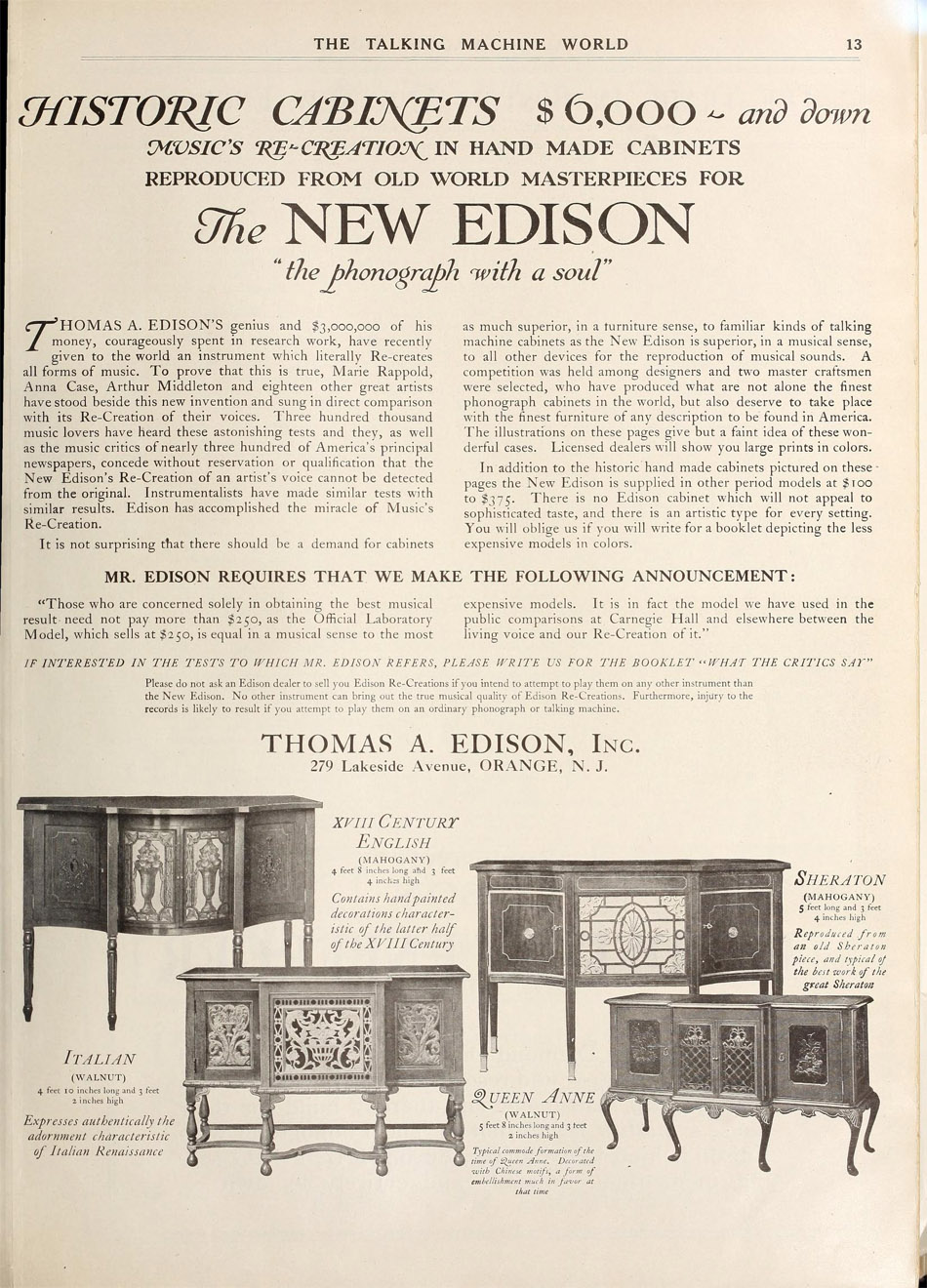
The Talking Machine
World, January 15, 1917
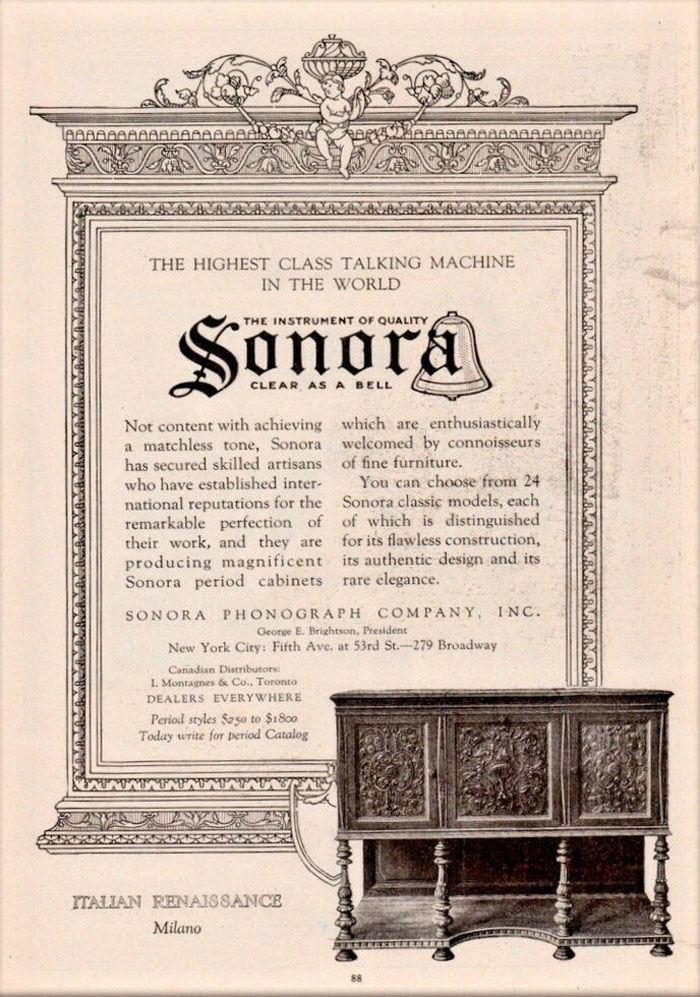
"...Sonora
period cabinets which are enthusiastically welcomed by connoisseurs
of fine furniture."
Italian Renaissance
Milano, Sonora 1921
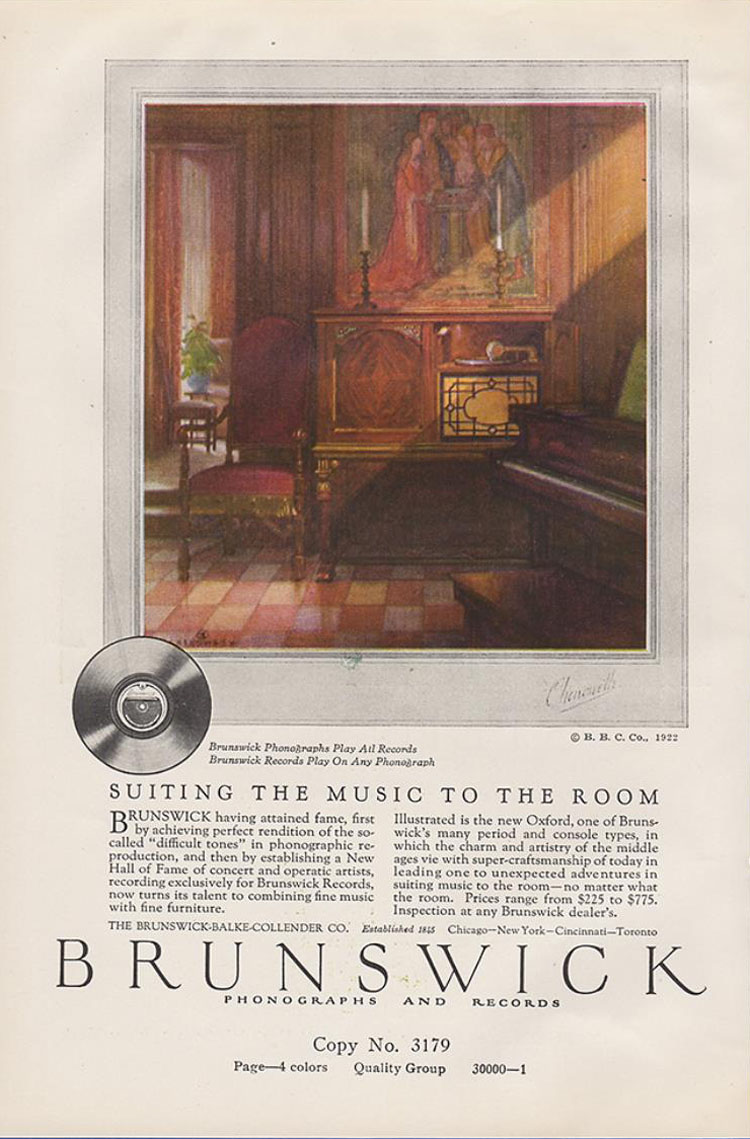
Brunswick first by
"achieving perfect rendition...in phonographic reproduction...now
turns its talent to combining fine music with fine furniture."
1922
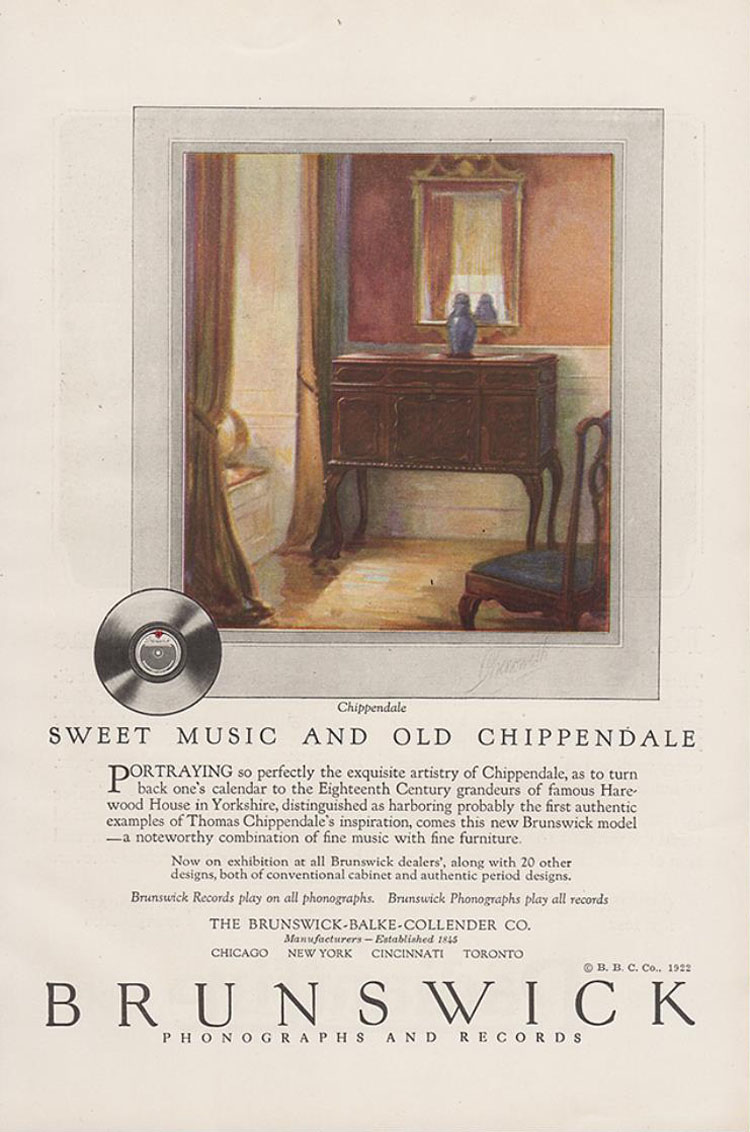
Brunswick - a noteworthy
combination of fine music with fine furniture, 1922
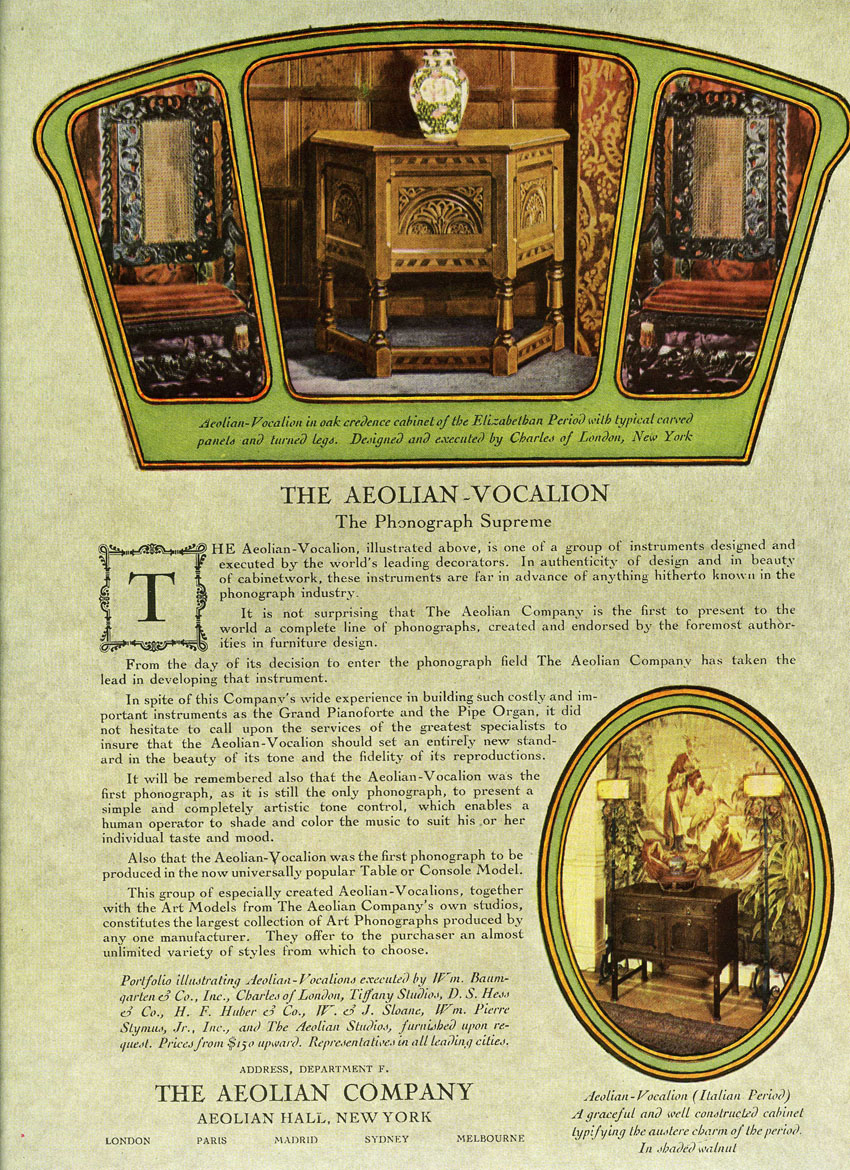
Aeolian-Vocalion
(Elizabethan and Italian Periods), 1923 (PM-2019)
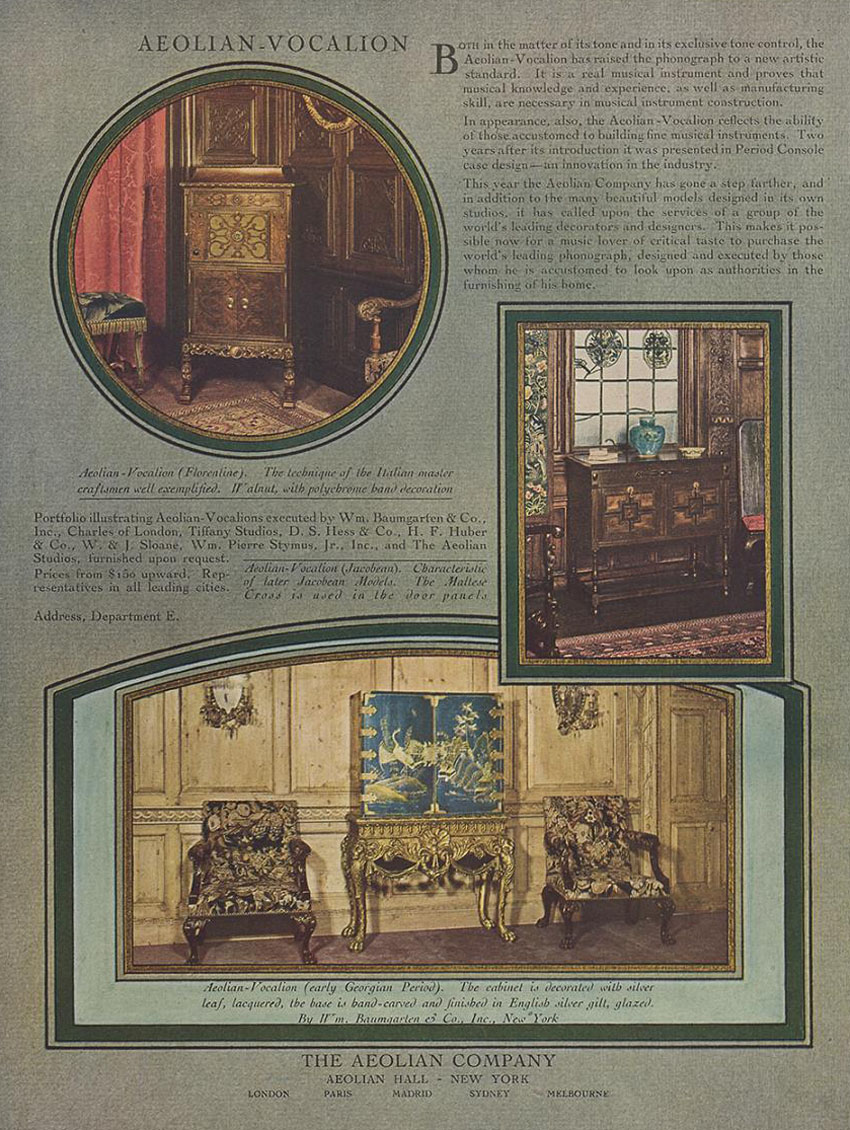
Aeolian-Vocalion
(early Georgian Period) advertisement, 1923
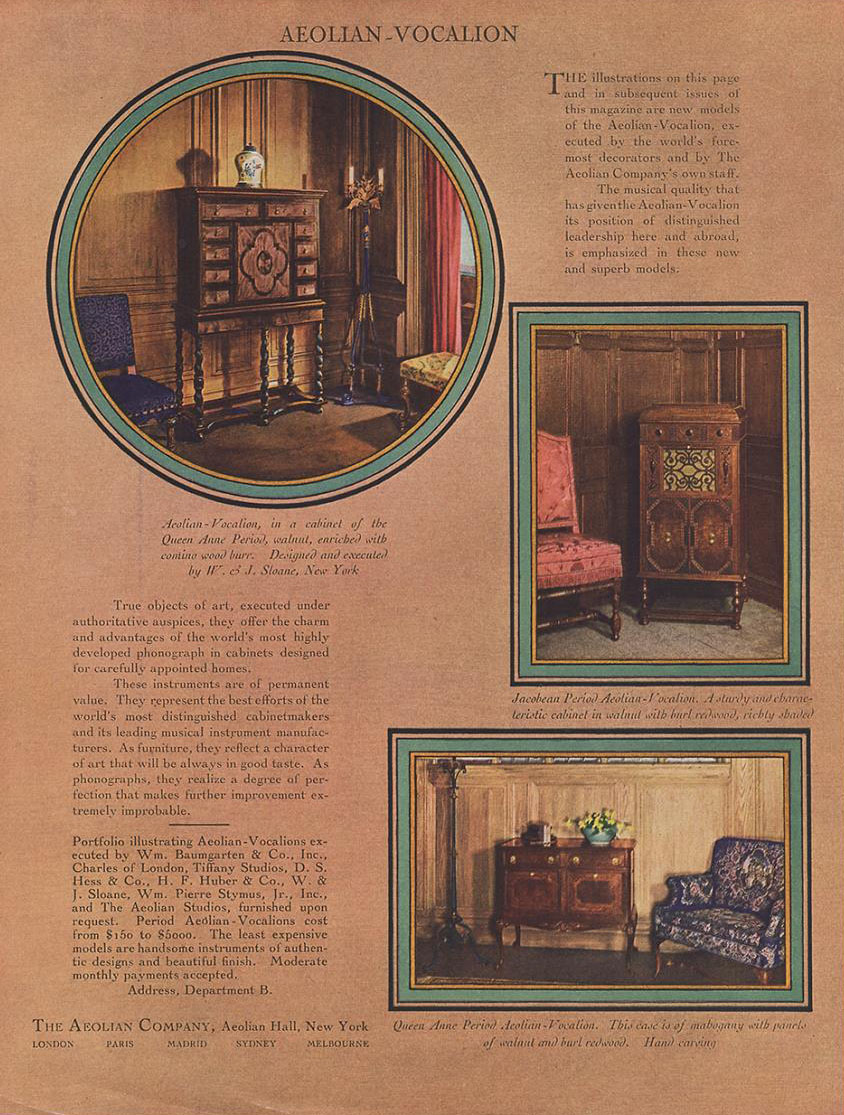
Aeolian-Vocalion
(Quenn Anne Period) advertisement, 1923

Brunswick Brochure,
1920
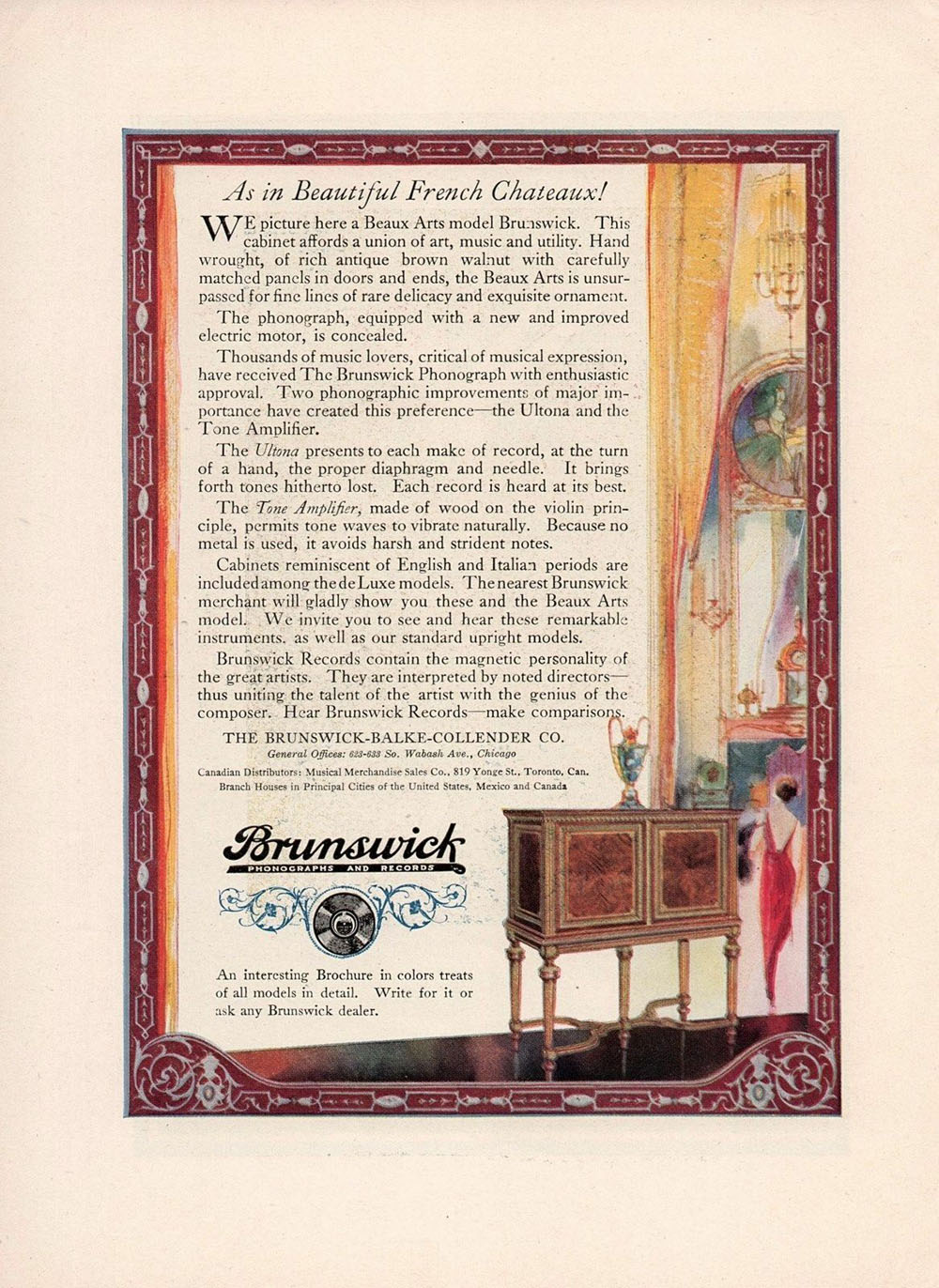
Brunswick Brochure,
1920
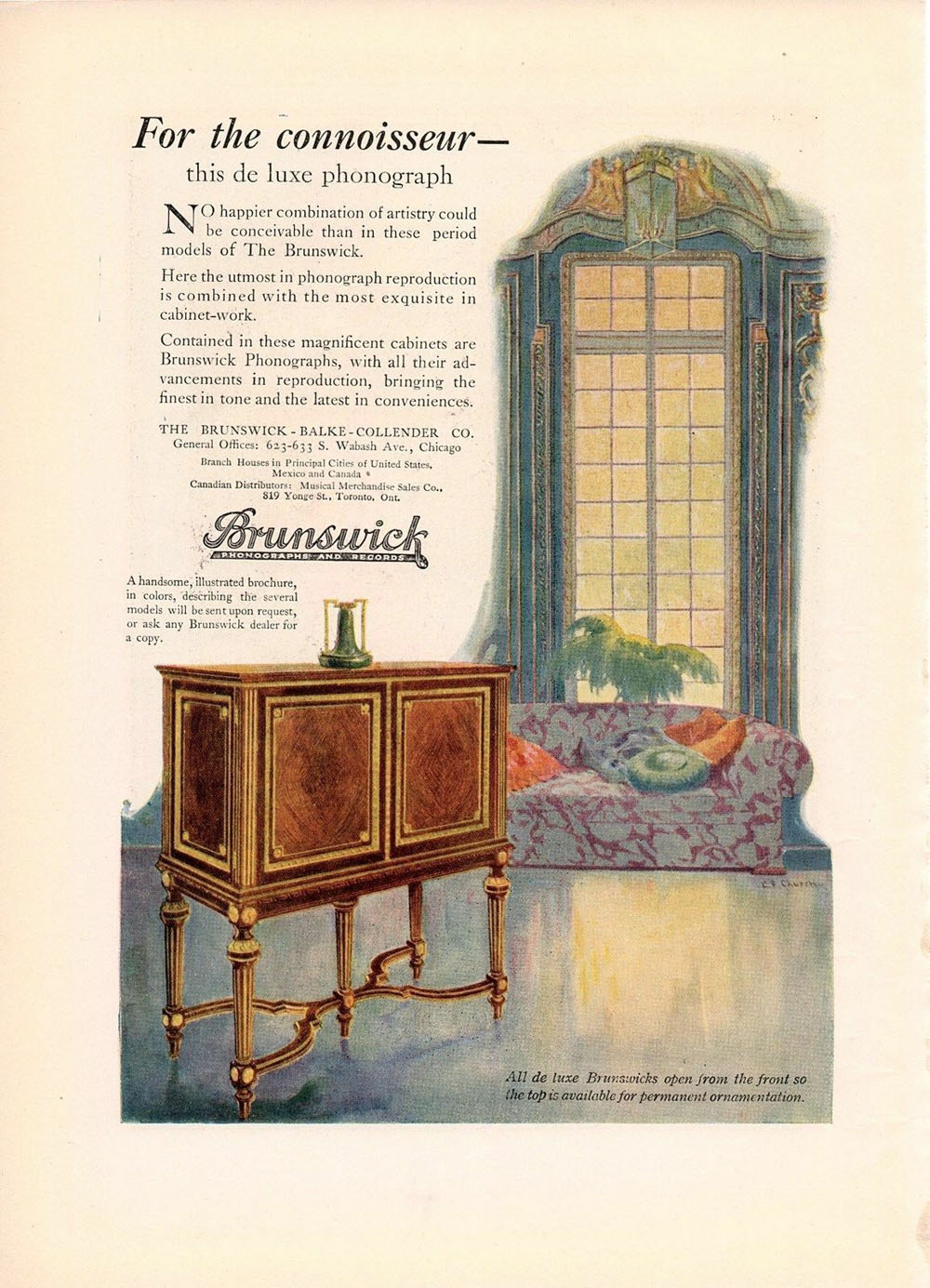
Brunswick Brochure,
1920

"Finer phonographs
are unknown." Brunswick Brochure, 1920
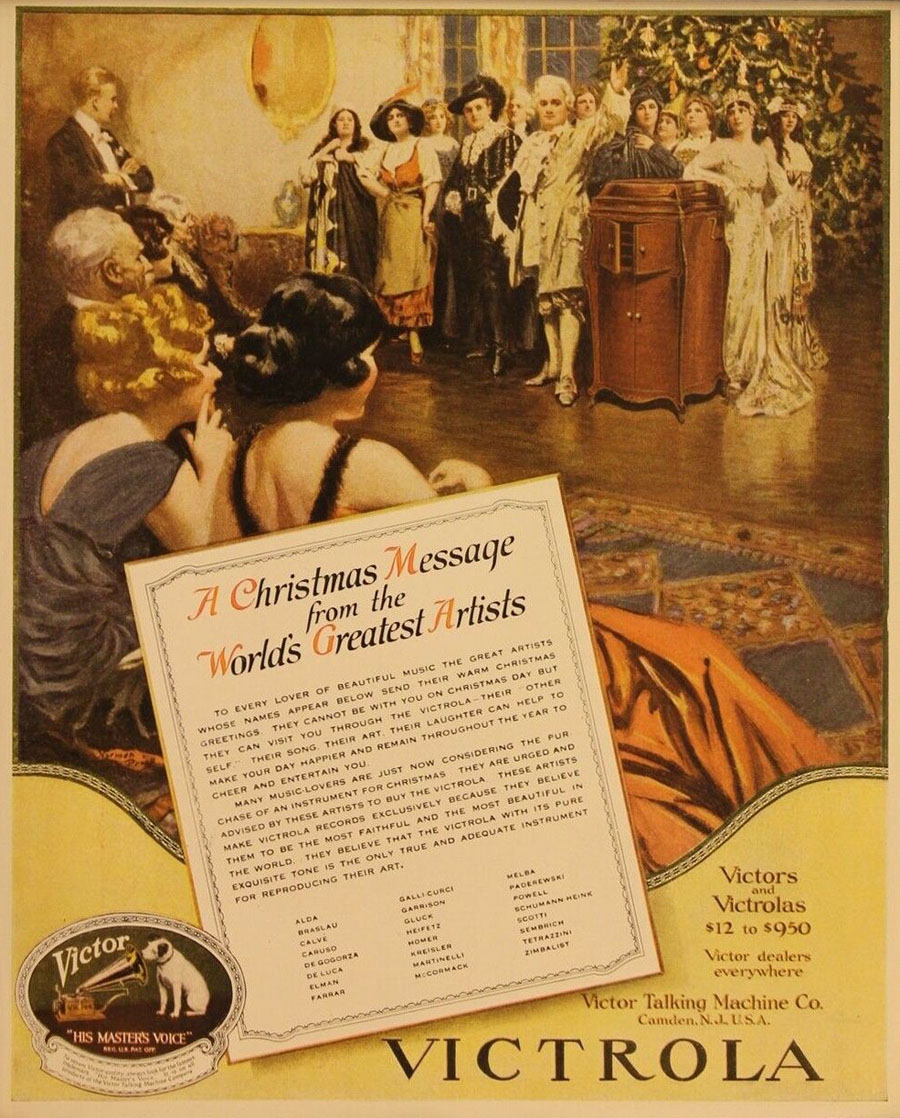
Christmas Message
from the World's Greatest Artists, Victrola 1919

"The Victrola
-- the only instrument that brings the world's greatest artists
into your home," Victrola Brochure, 1919
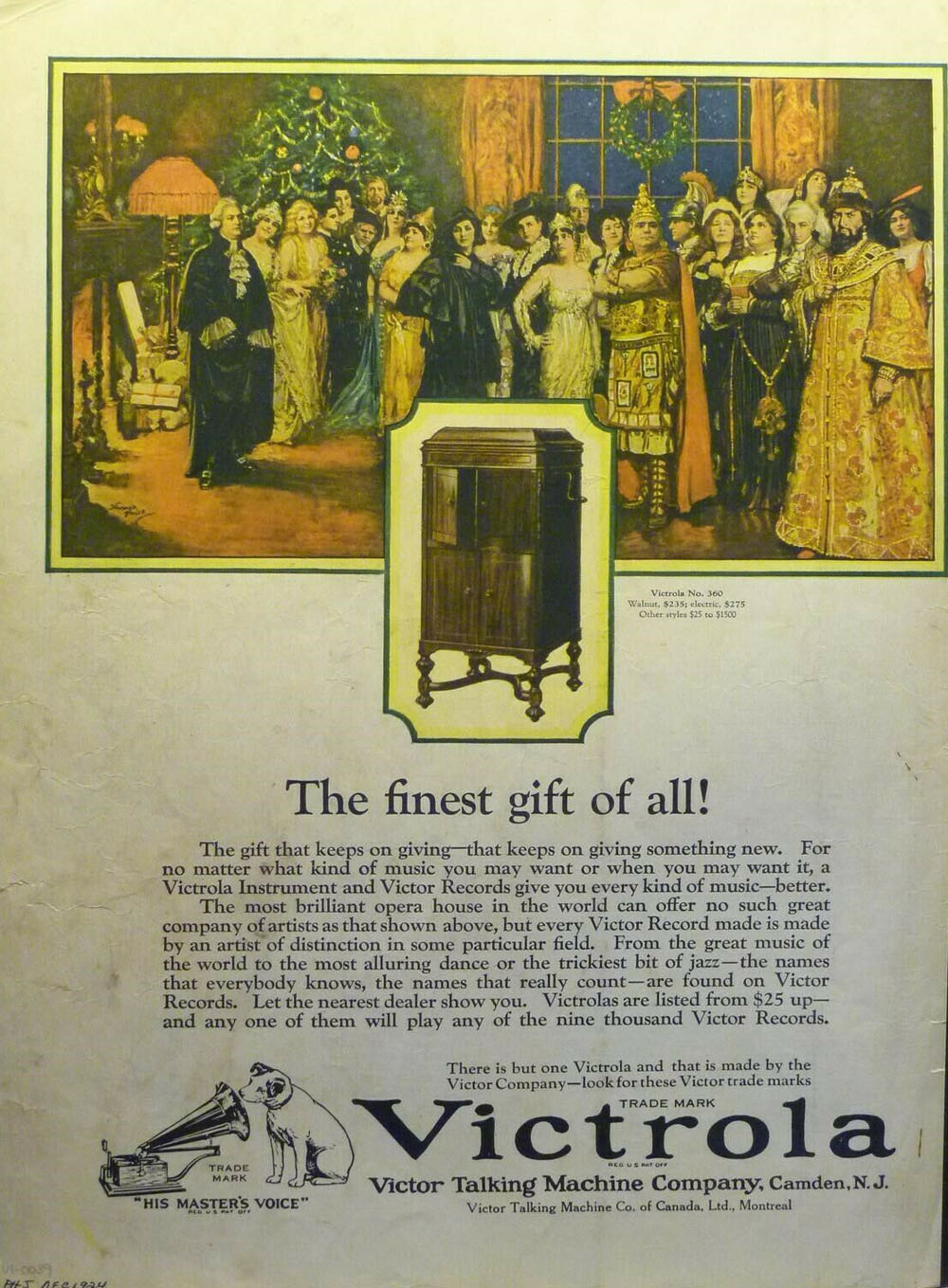
"The finest
gift of all!" "The most brilliant opera house in the
world can offer no such great company of artists as that shown
above...Victrola" 1924
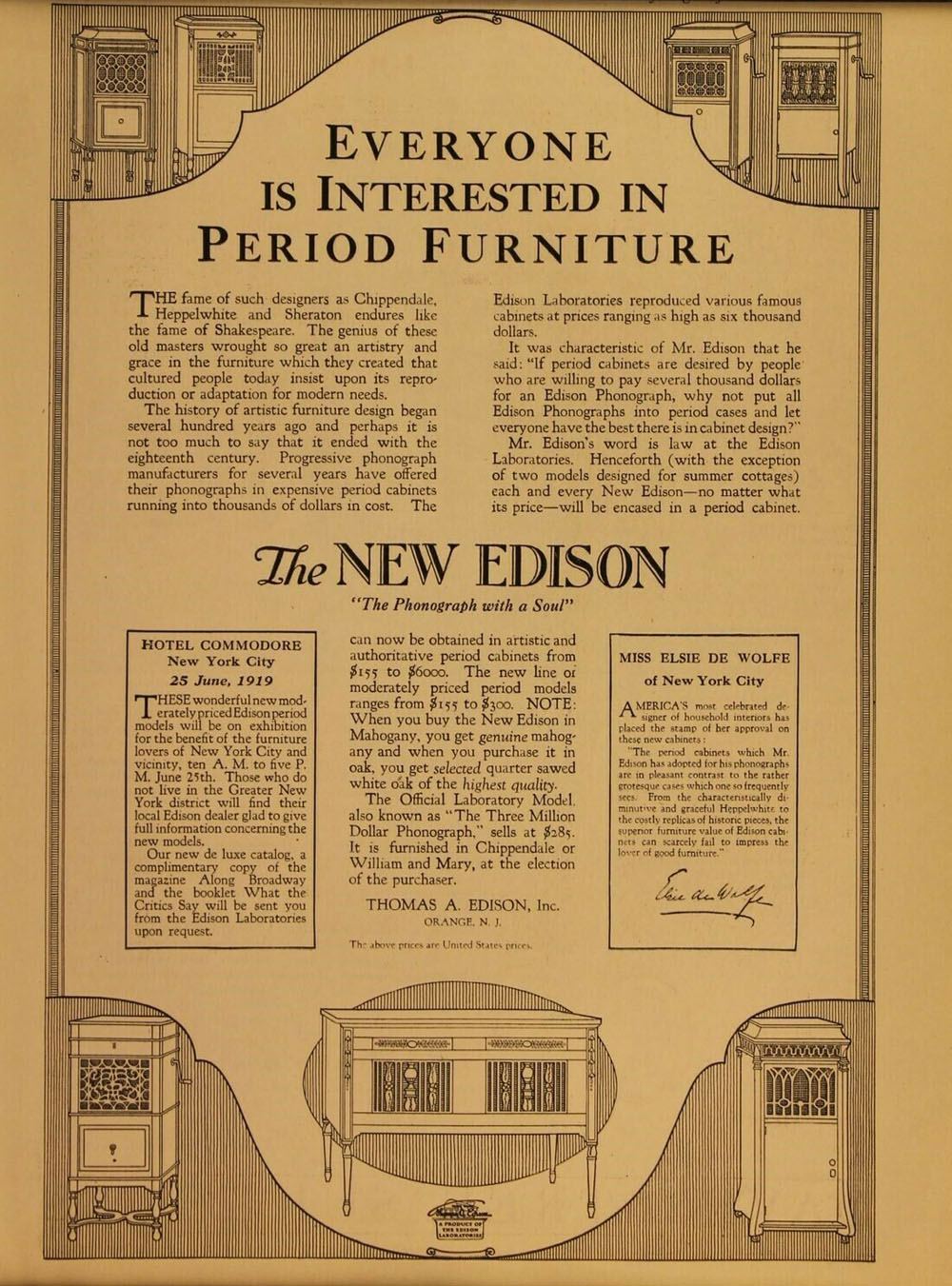
Edison Period Furniture, 1919
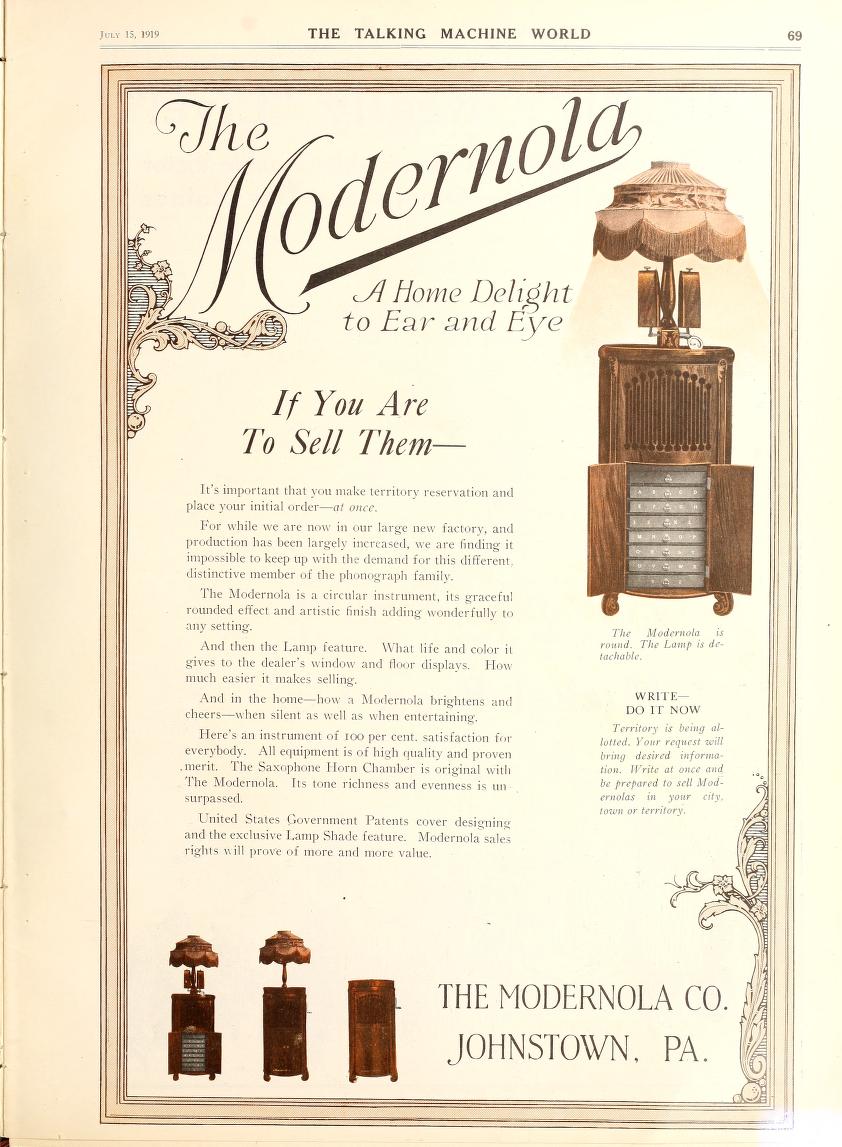
A Home Delight to Ear and
Eye, The Modernola, July 1919
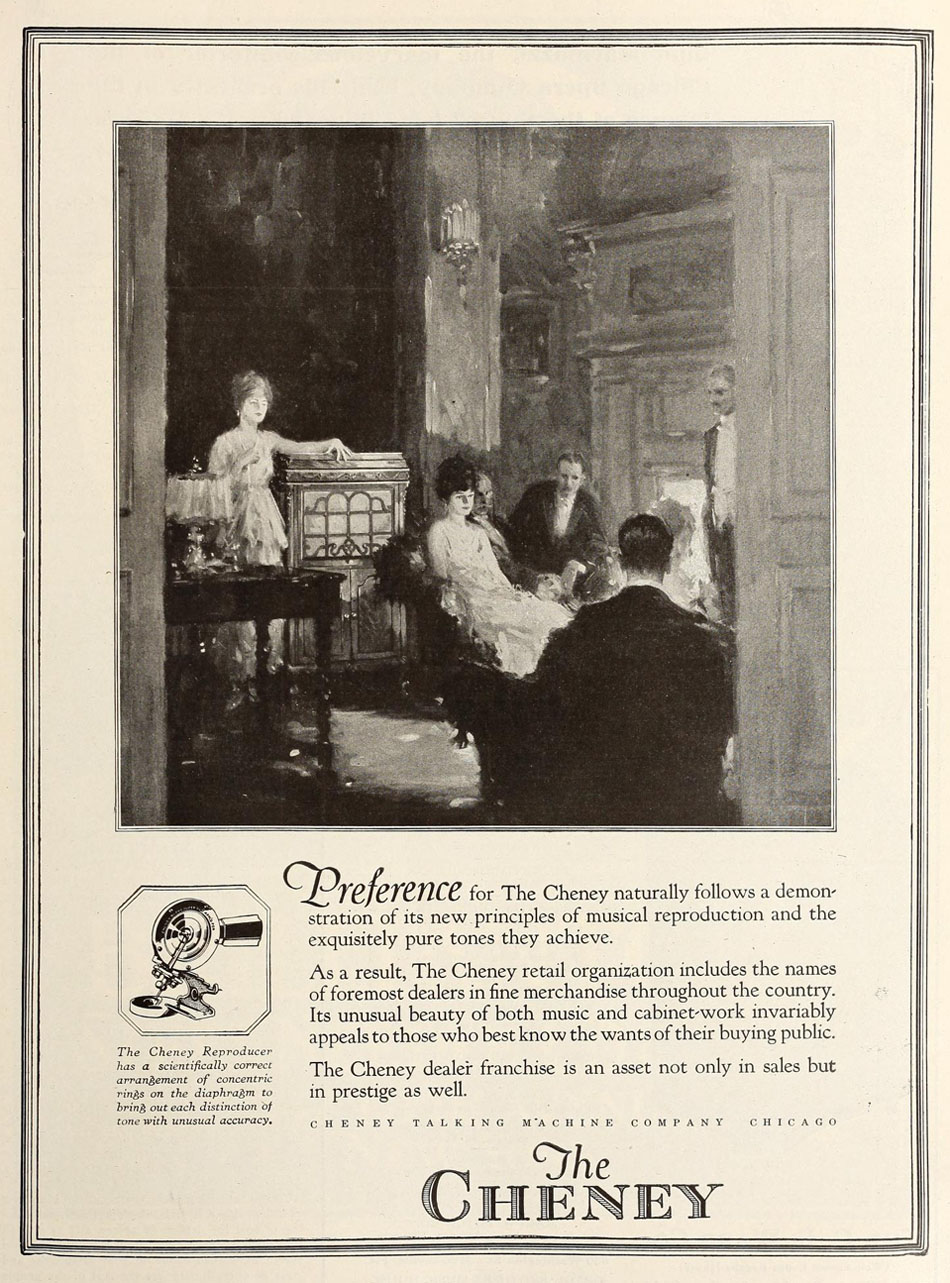
"Preference for the The Cheney,"
The Talking Machine World, August 1920
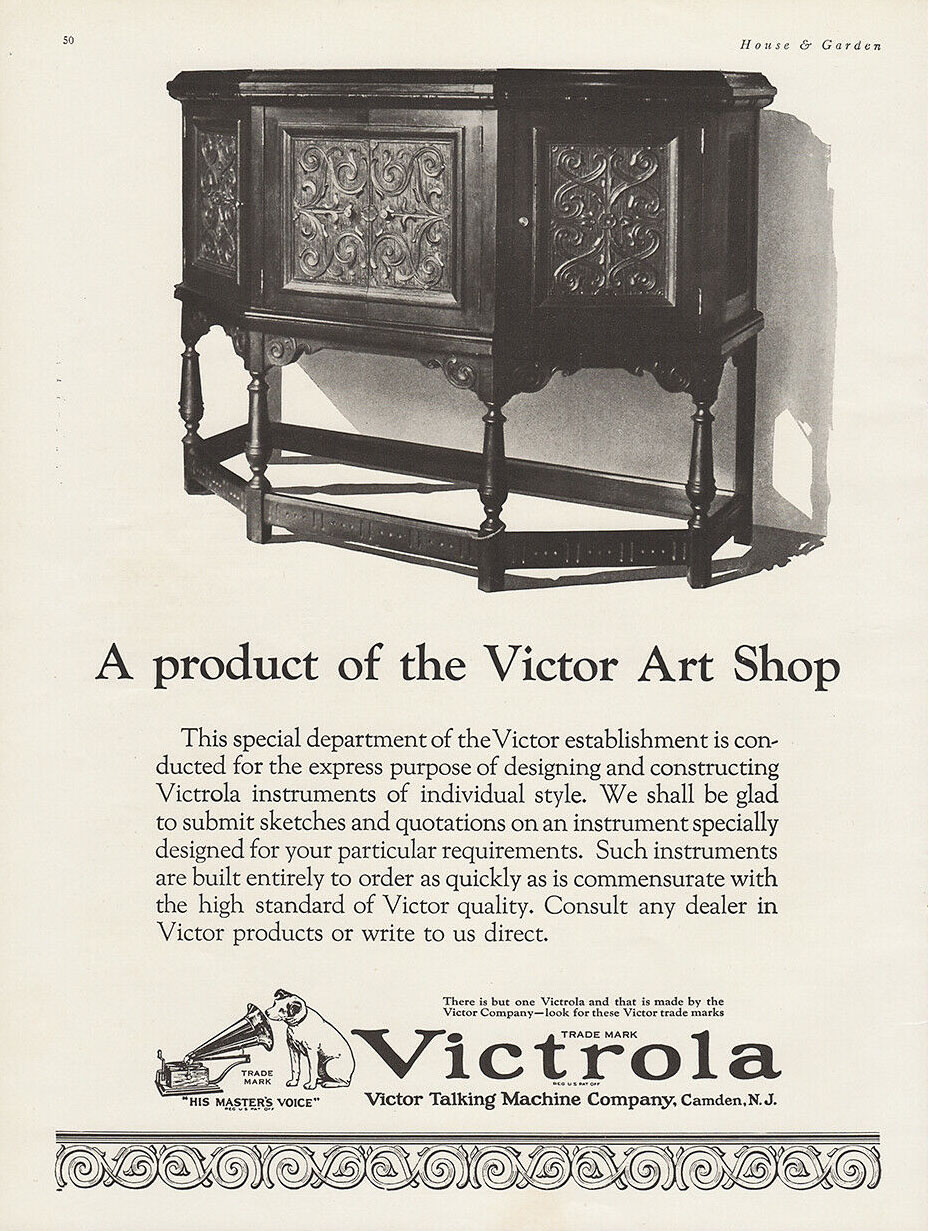
Custom Victrolas available, 1924
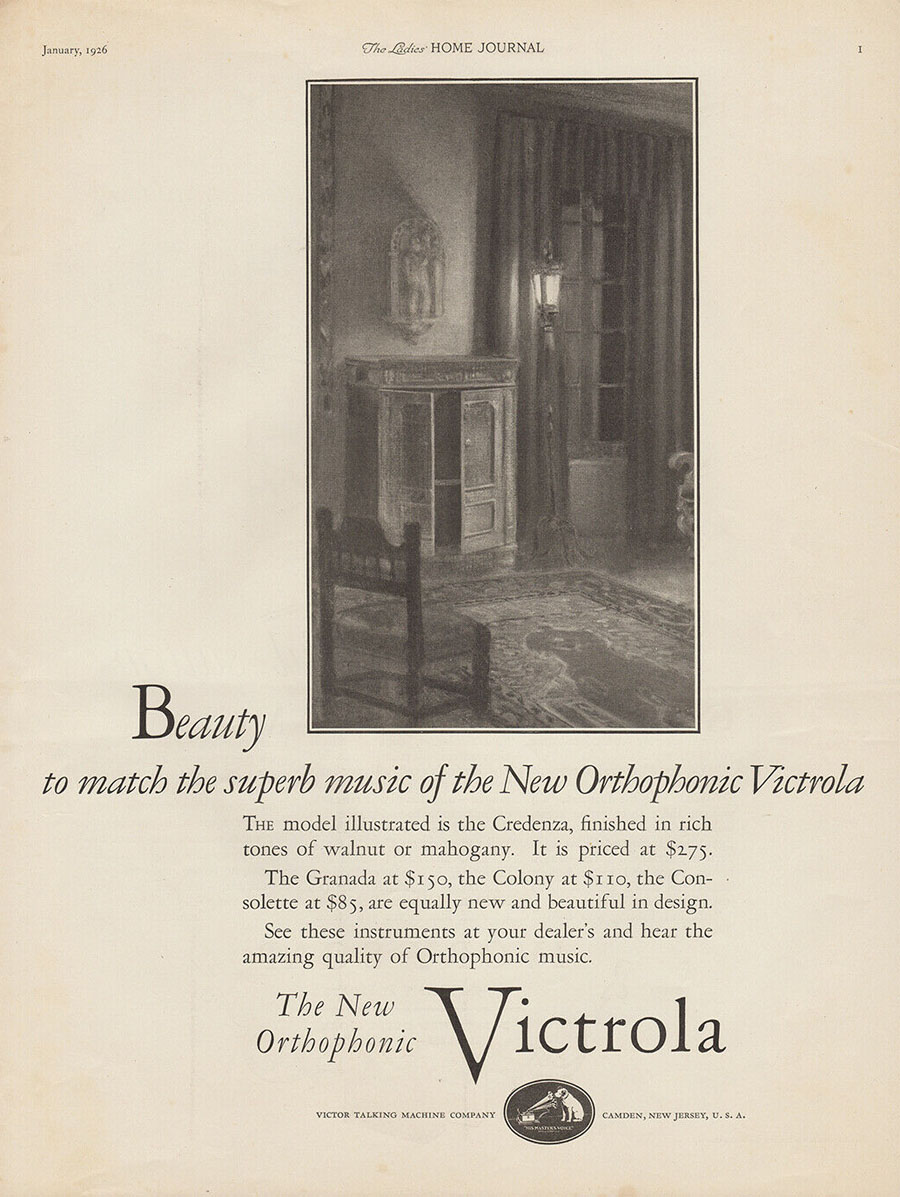
"Beauty to match the superb
music" The Ladies Home Journal 1926
"With the introduction of the Orthophonic
Victrolas in 1925, every standard console cabinet received a period
designation. Most styles were Mediterranean or English in ancestry,
with new Italian and Spanish influences prominent in the selection."
from Look for the Dog by Robert W. Baumbach (2).
For more information about Period Victrolas 1917-1925 see Baumbach's
book and Endnote 3 - Period Victrolas.
The Radio-Phonograph
When the radio entered the home
in the early 1920's you listened with headphones or an external
speaker. Like the phonograph, the radio was advertised as a
wonder and a necessity for lovers of fine music. The variety
of what you could listen to on the radio, however, soon made
it obvious that it's power to bring the whole world into your
home had enlarged. Additionally, that entertainment 'over the
air waves' was free.
By the late 1920's cabinets containing
a radio and a phonograph were being offered and just like the
evolution of the phonograph the horns of the radios moved inside
cabinets. The cabinet became part of the marketing and period
pieces for a radio were offered as an elegant option.

The RCA Radiola,
December 1929
RCA (now the owner of the Victor
Talking Machine) advertised their Radiola in combination with
electrical phonograph as "Music from the air or record."
Like the Victrola that evolved from the Victor, RCA called their
radio the "Radiola." See the "Ola
Brands" for examples of phonographs being named 'olas'
and some examples of radio companies likewise incorporating
that suffix.
Musaphonic
Elegance
In the 1940's General Electric's
Musaphonic radio-phonograph had an advertising campaign featuring
the elegance and pleasure the Musaphonic could add to your home.
Notice in the following three
ads, for "you who love music," how the designer dressed
women are featured in elegant atmospheres with the Musaphonic
offering the consumer "a new world of pleasure," and
how dress designers and master craftsmen creating the period
furniture were acknowledged for their contributions to this
elegant room.
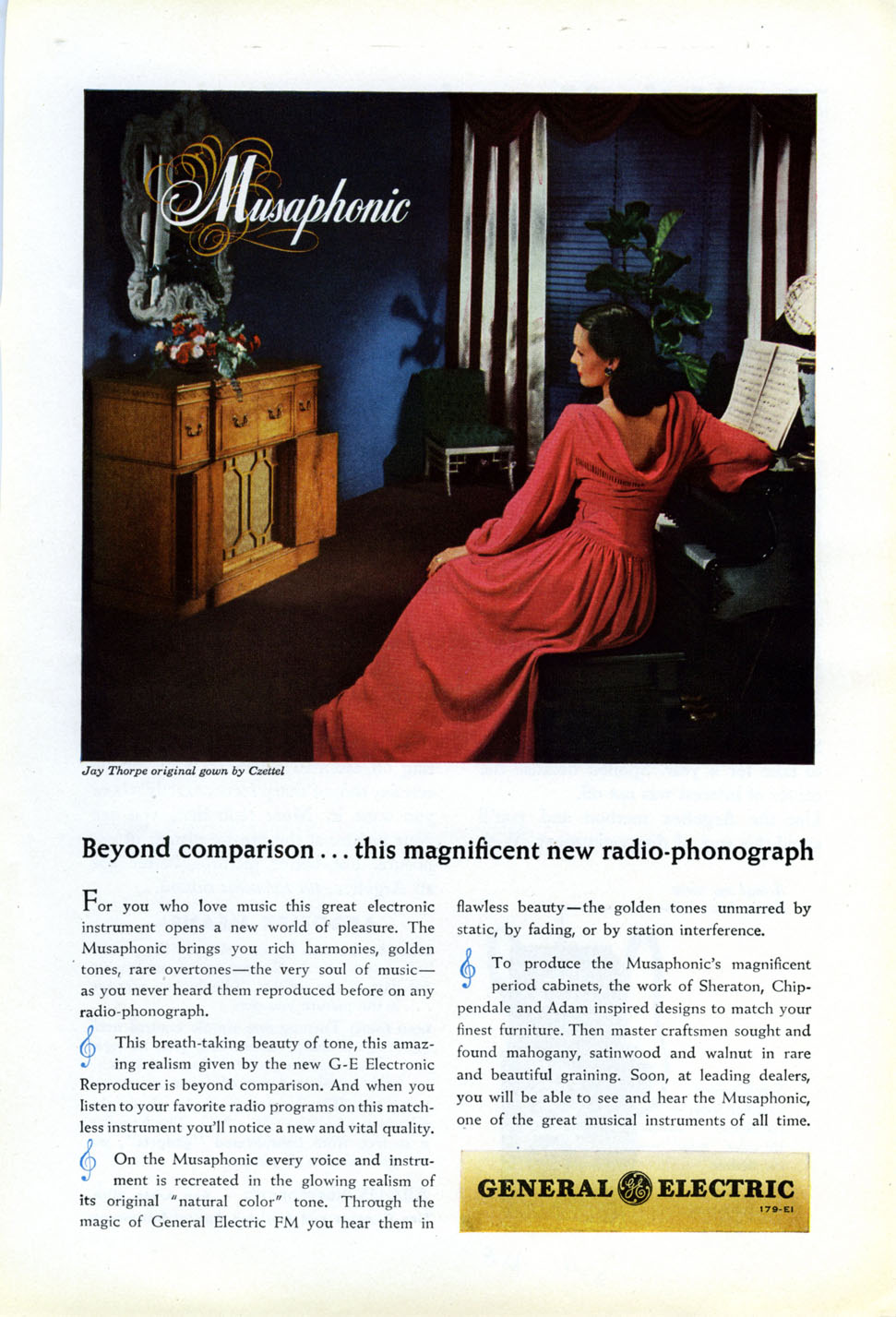
GE Musaphonic, The
National Geographic Magazine, 1946 (Jay Thorpe original gown
by Czettel). (PM-1753)
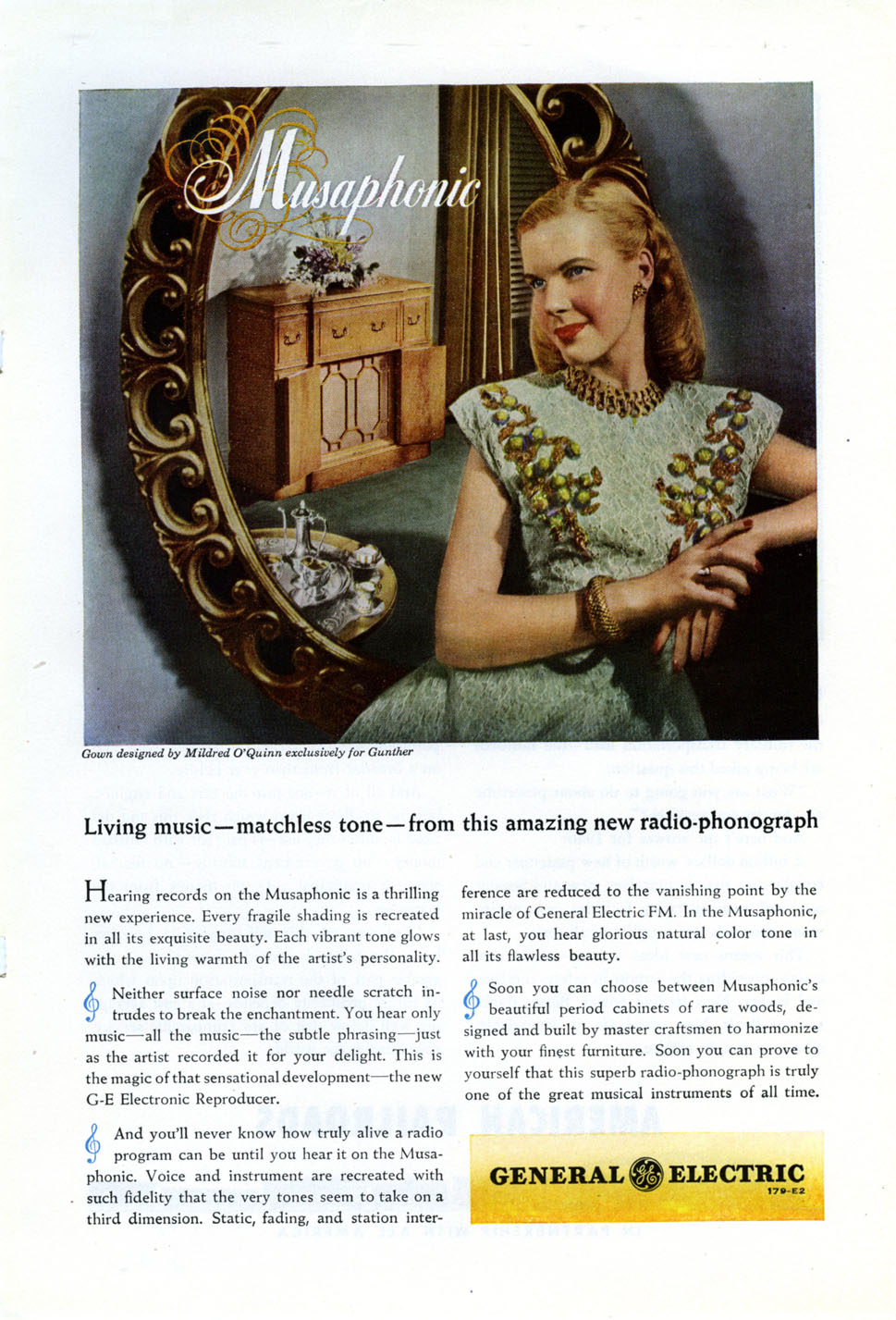
GE Musaphonic, The
National Geographic Magazine, 1944 (Gown designed by Mildred
O'Quinn exclusively for Gunther). (PM-1753)
GE Musaphonic, The
National Geographic Magazine, 1944 (Negligee by Edward J. Macksoud
Company). (PM-1757)
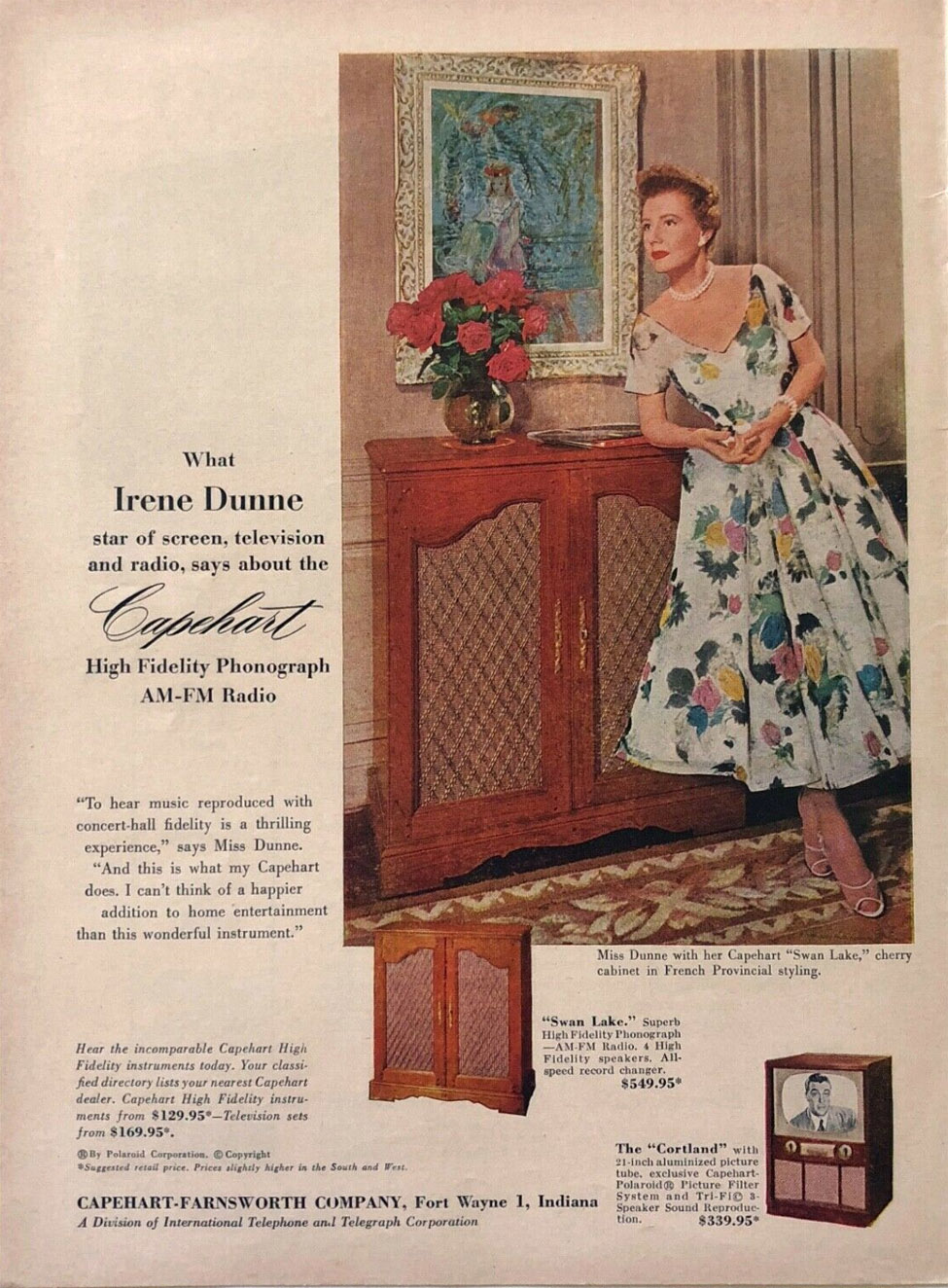
"'I can't think
of a happier addition to home entertainment than this wonderful
instrument." Irene Dunne
Capehart High Fidelity
Phonograph AM-FM Radio, 1954
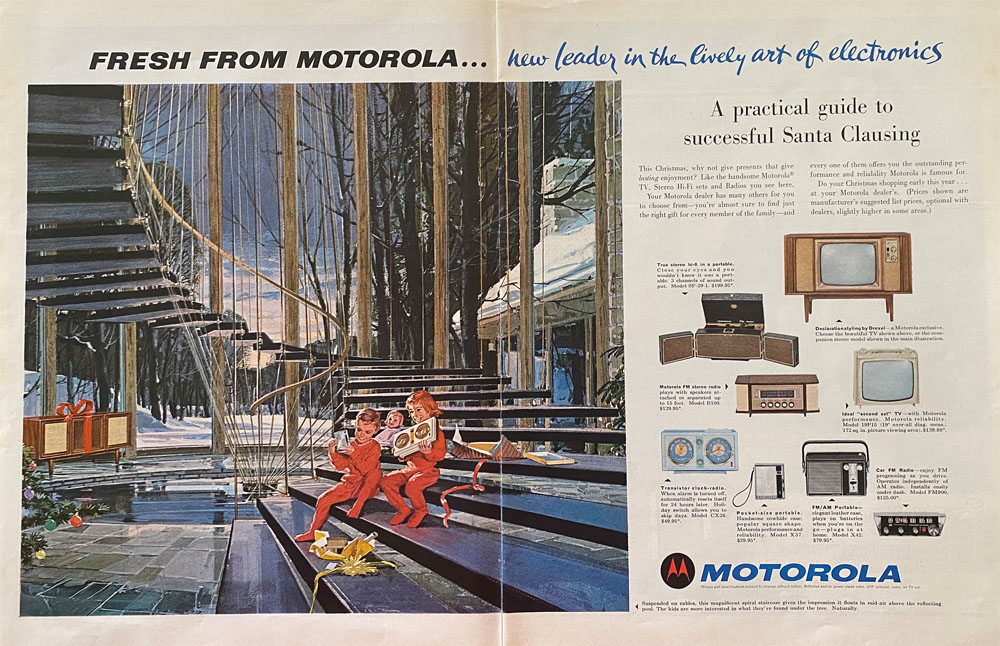
Motorola...new leader
in the lively art of electronics, Life, December 1962
Featuring "this
magnificent spiral staircase gives the impression it floats in
mid-air above the reflecting pool. The kids are more interested
in what they've found under the tree. Naturally."
2021
- The Flagship Phonograph Console
"we remember from decades past."
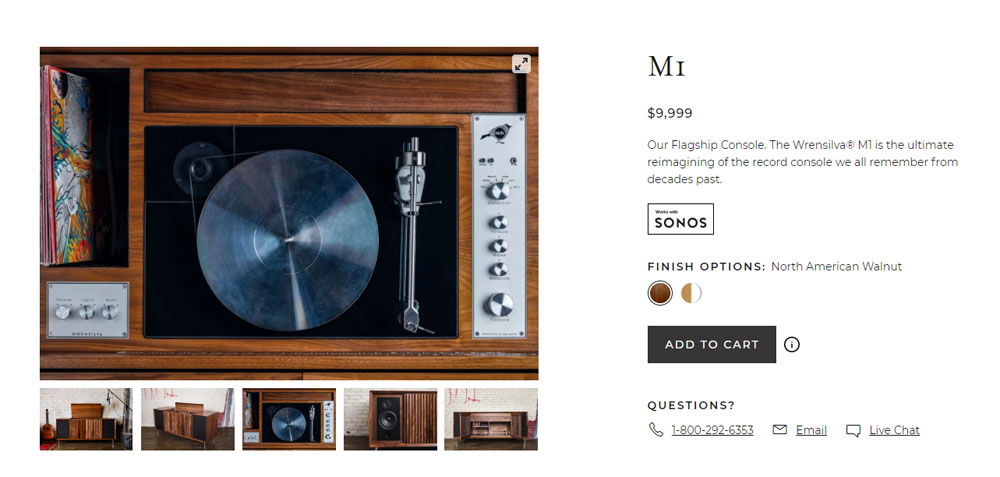
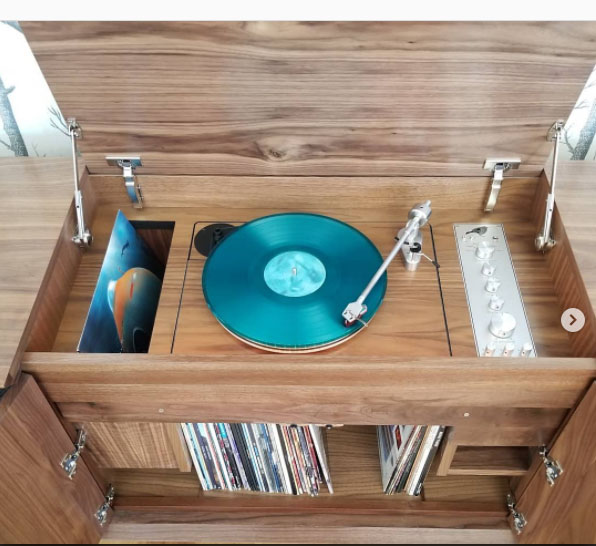
Wrensilva®
M1 January 2021
The phonograph continuum
lives on with the record player in its cabinet 'reimagined.'

Phonographia
|

